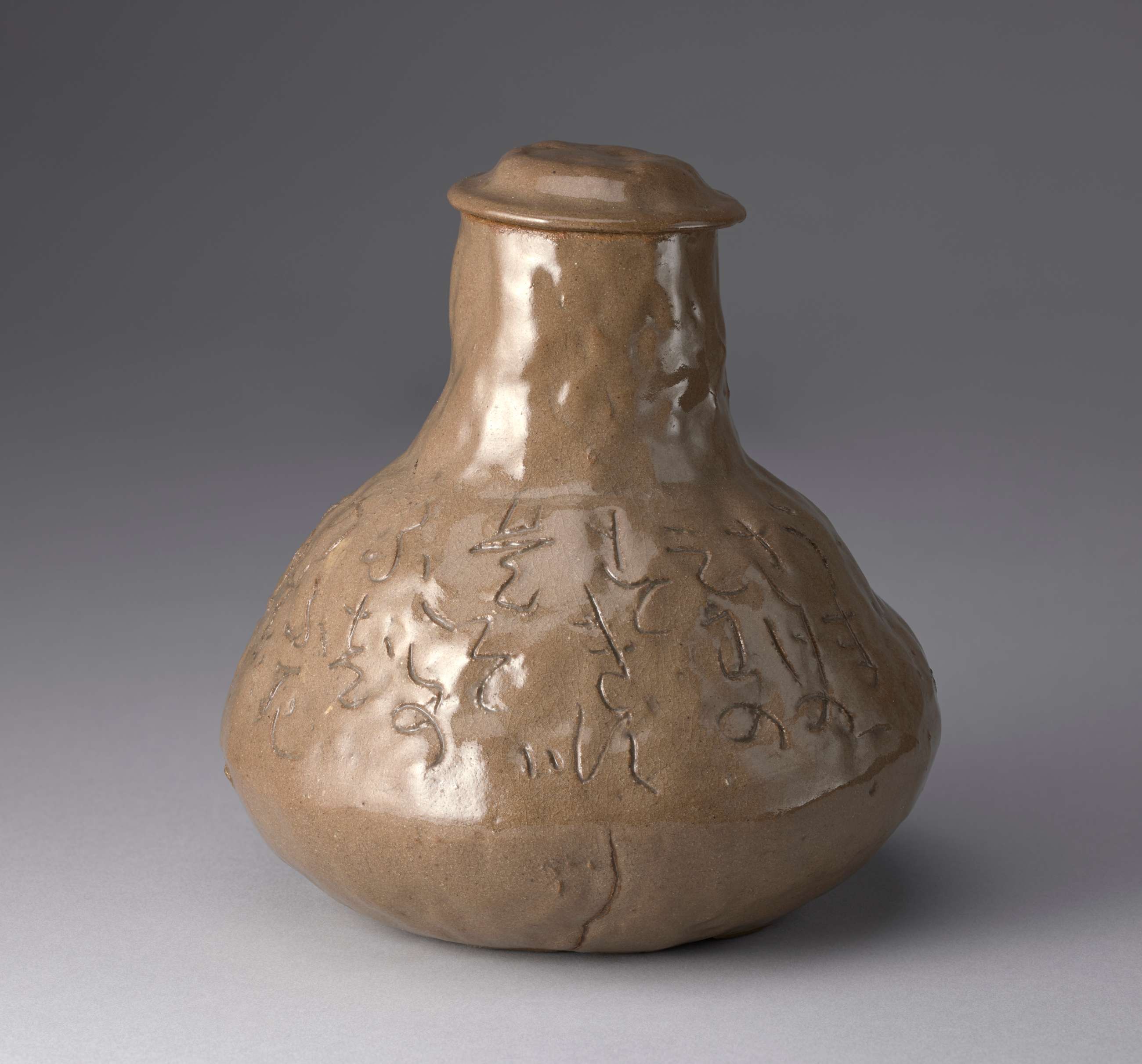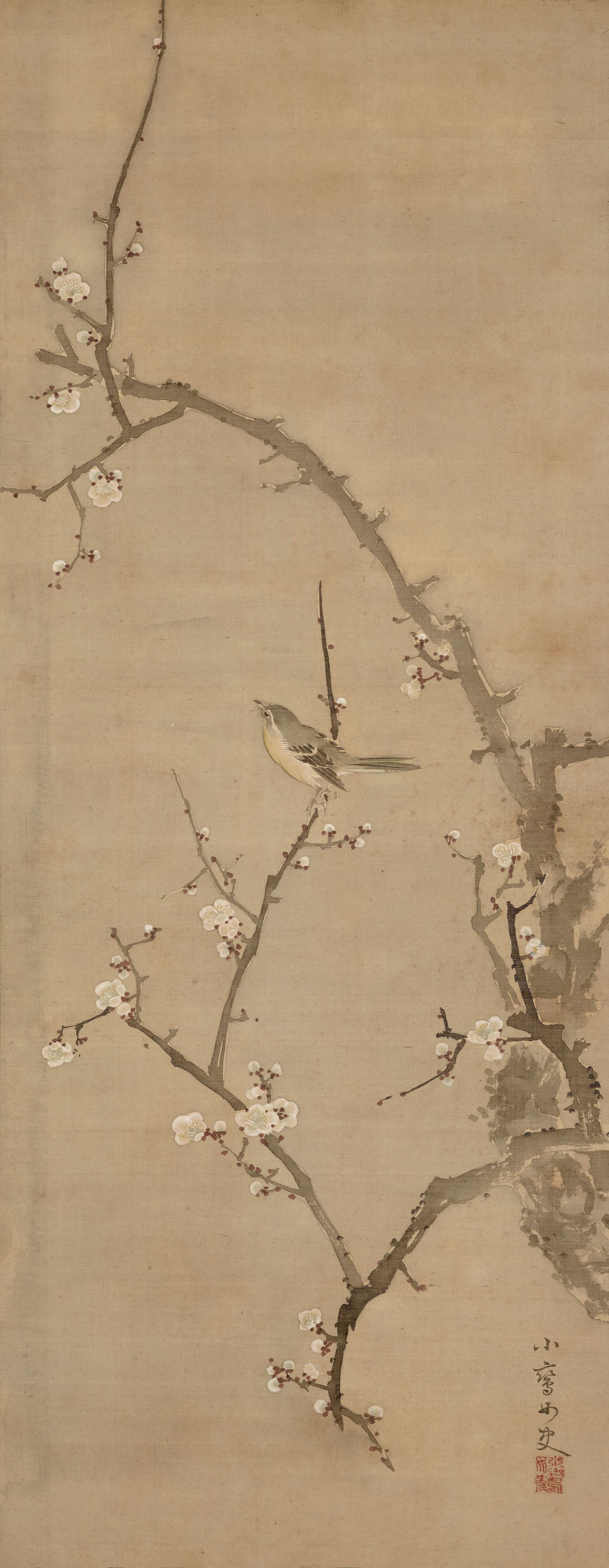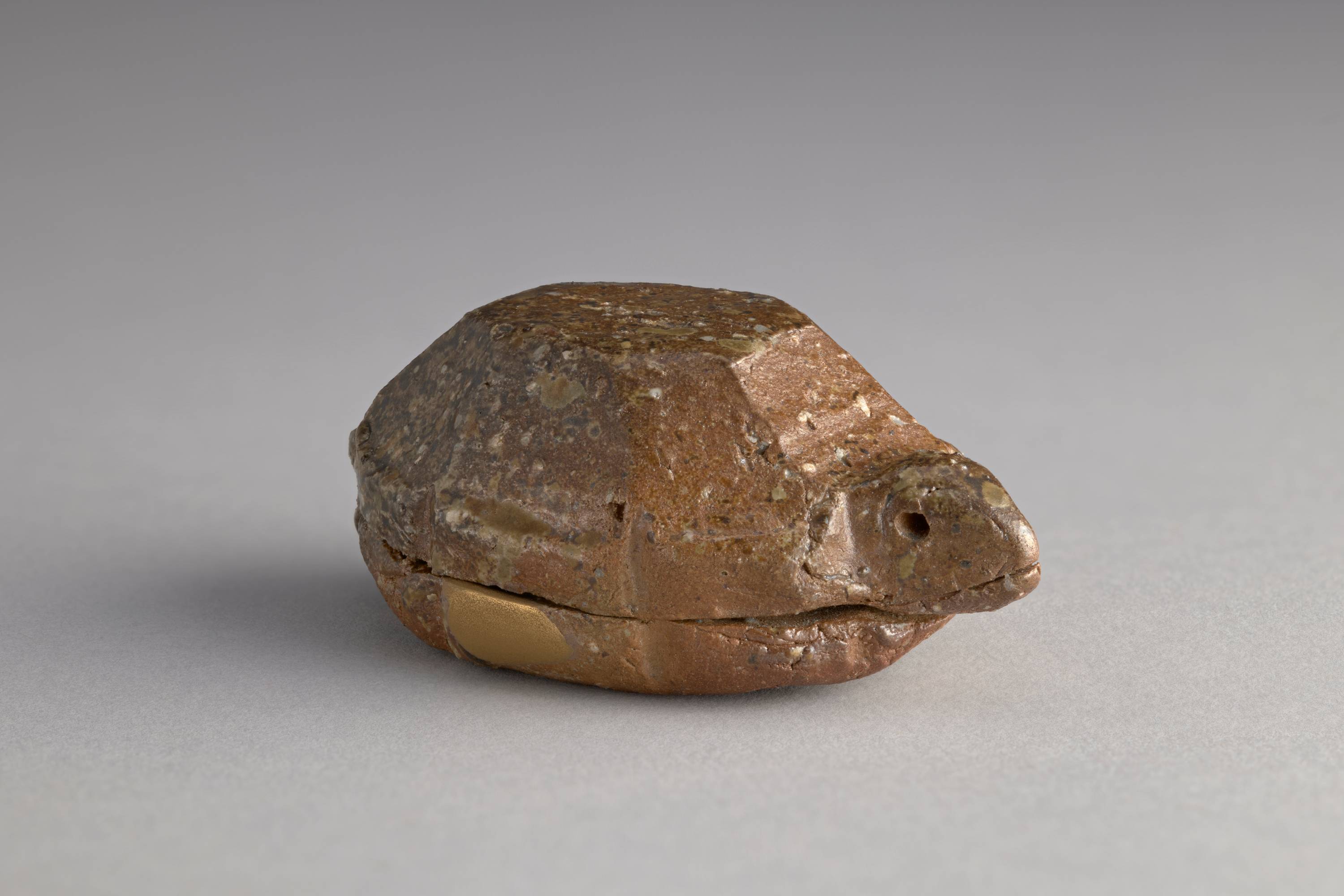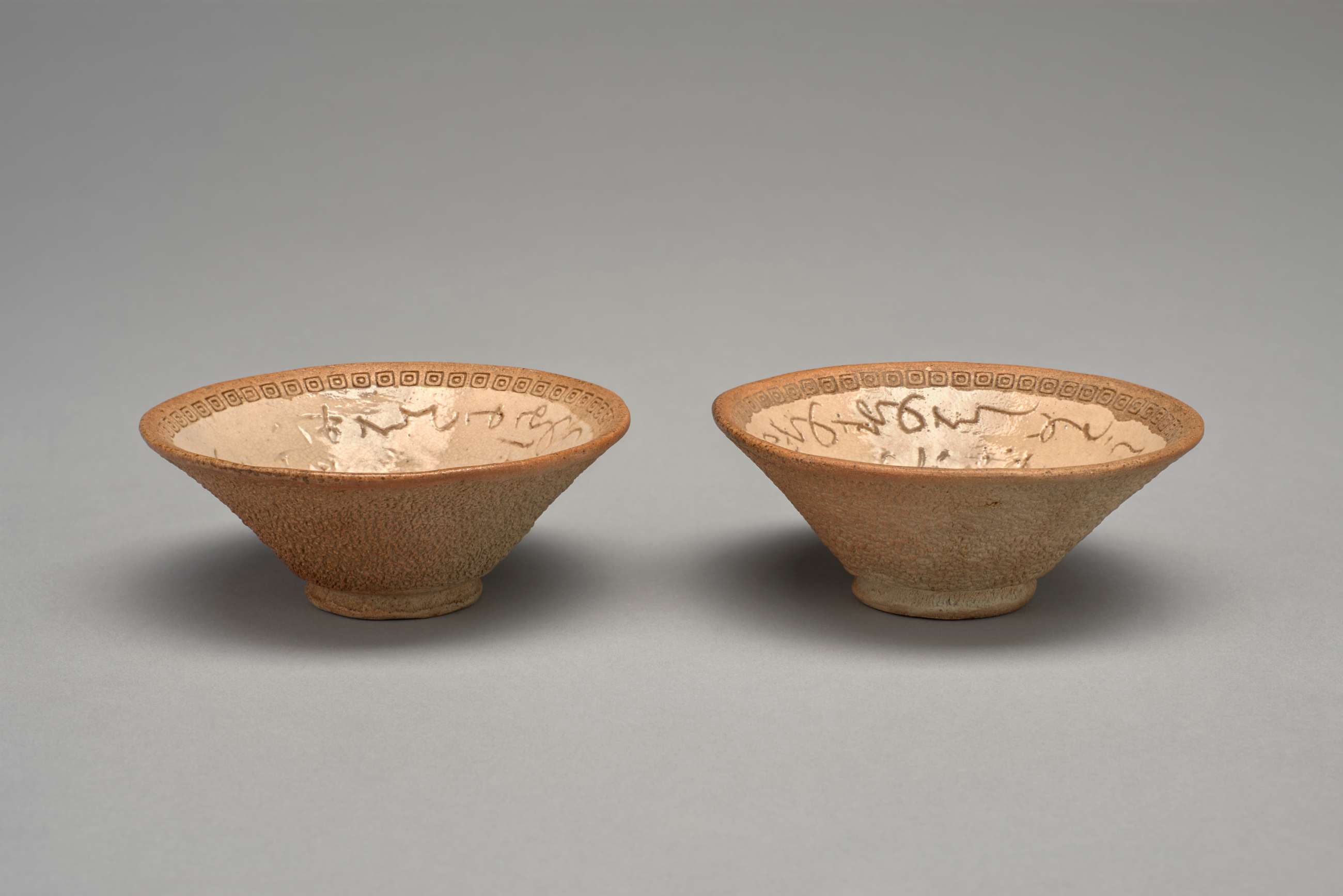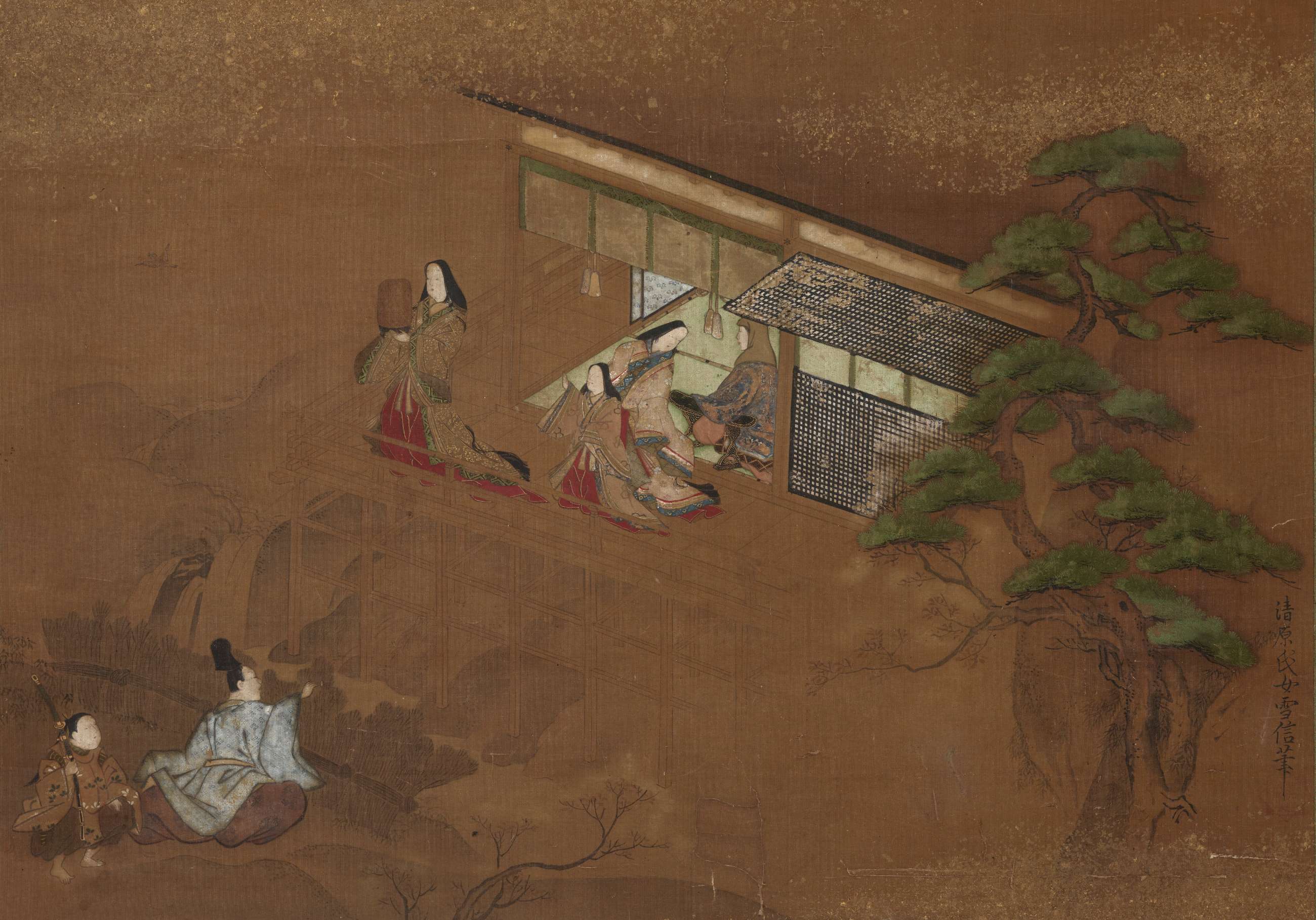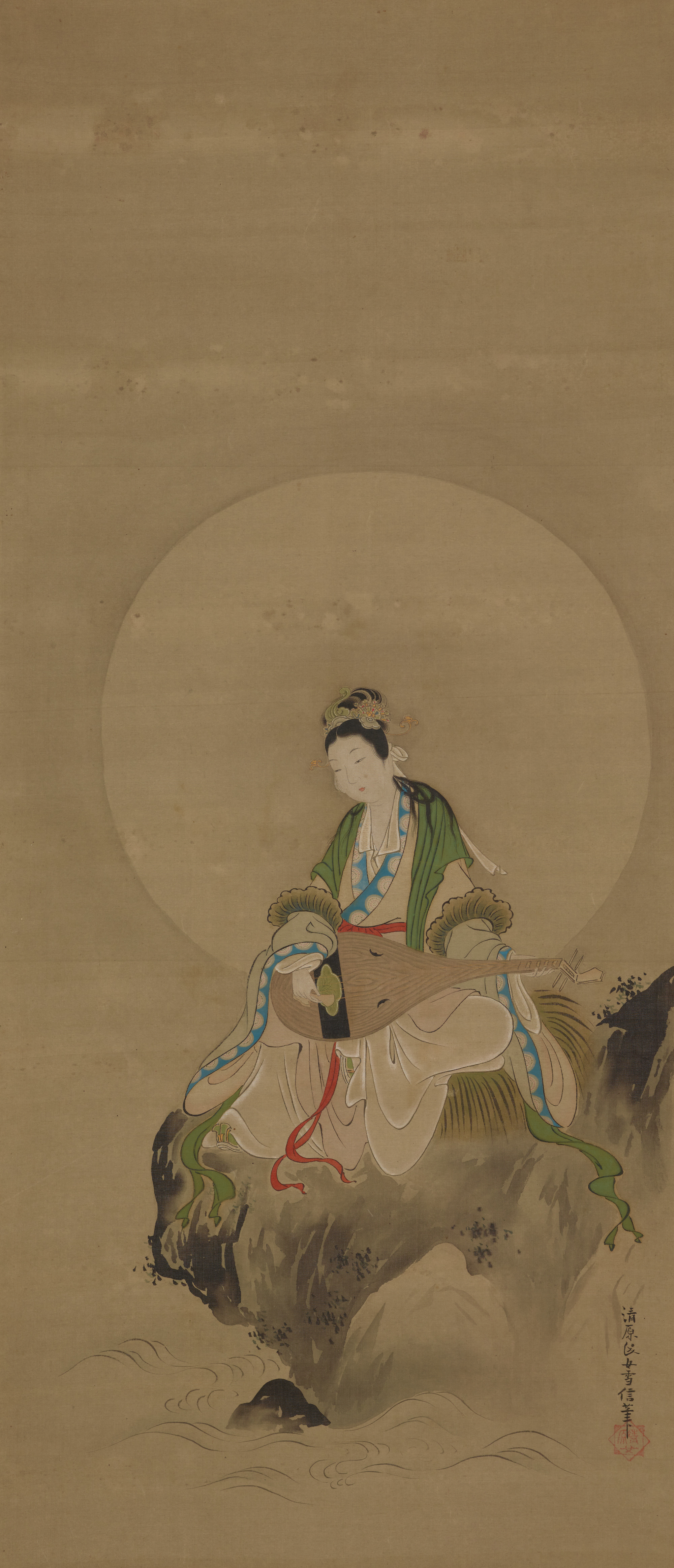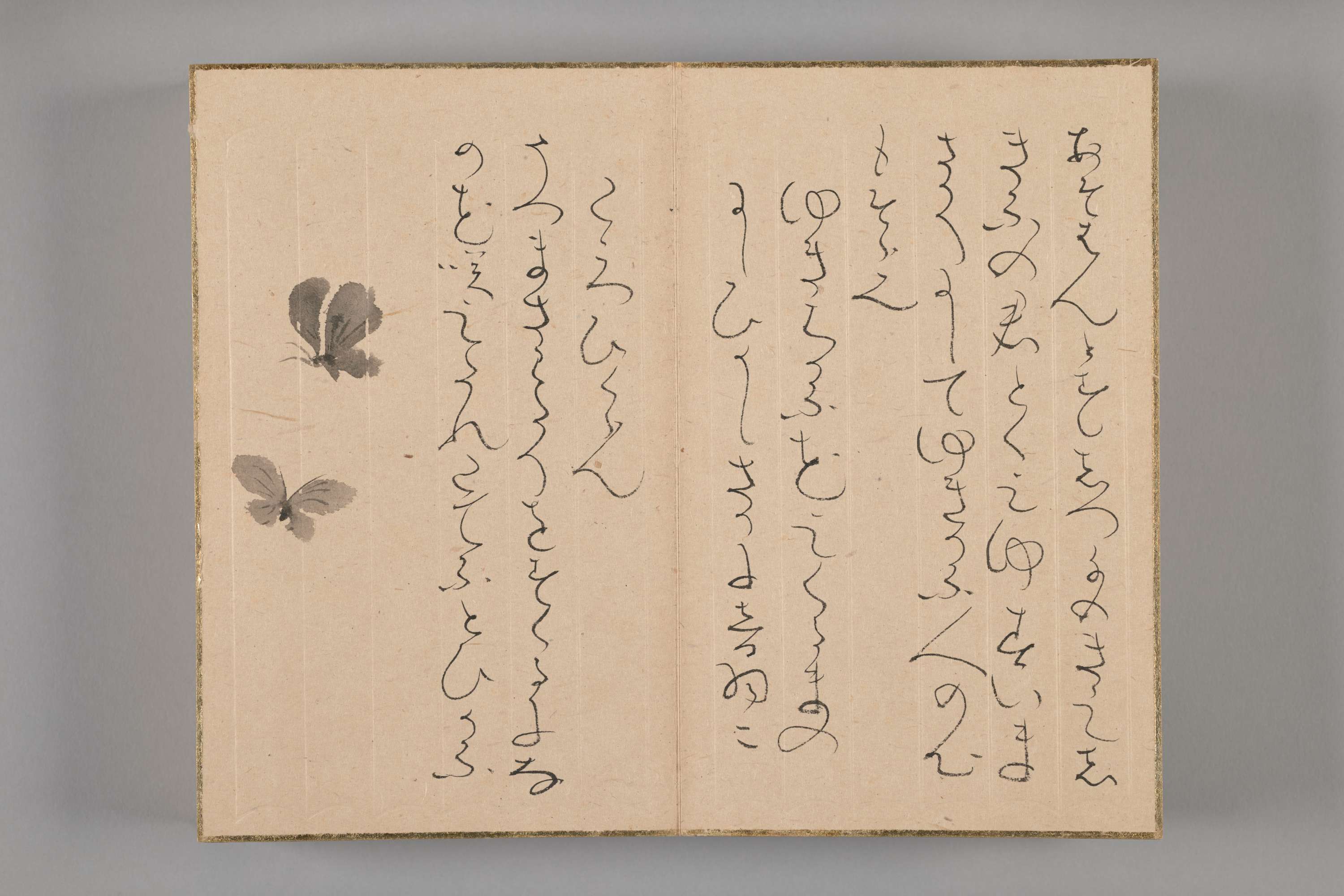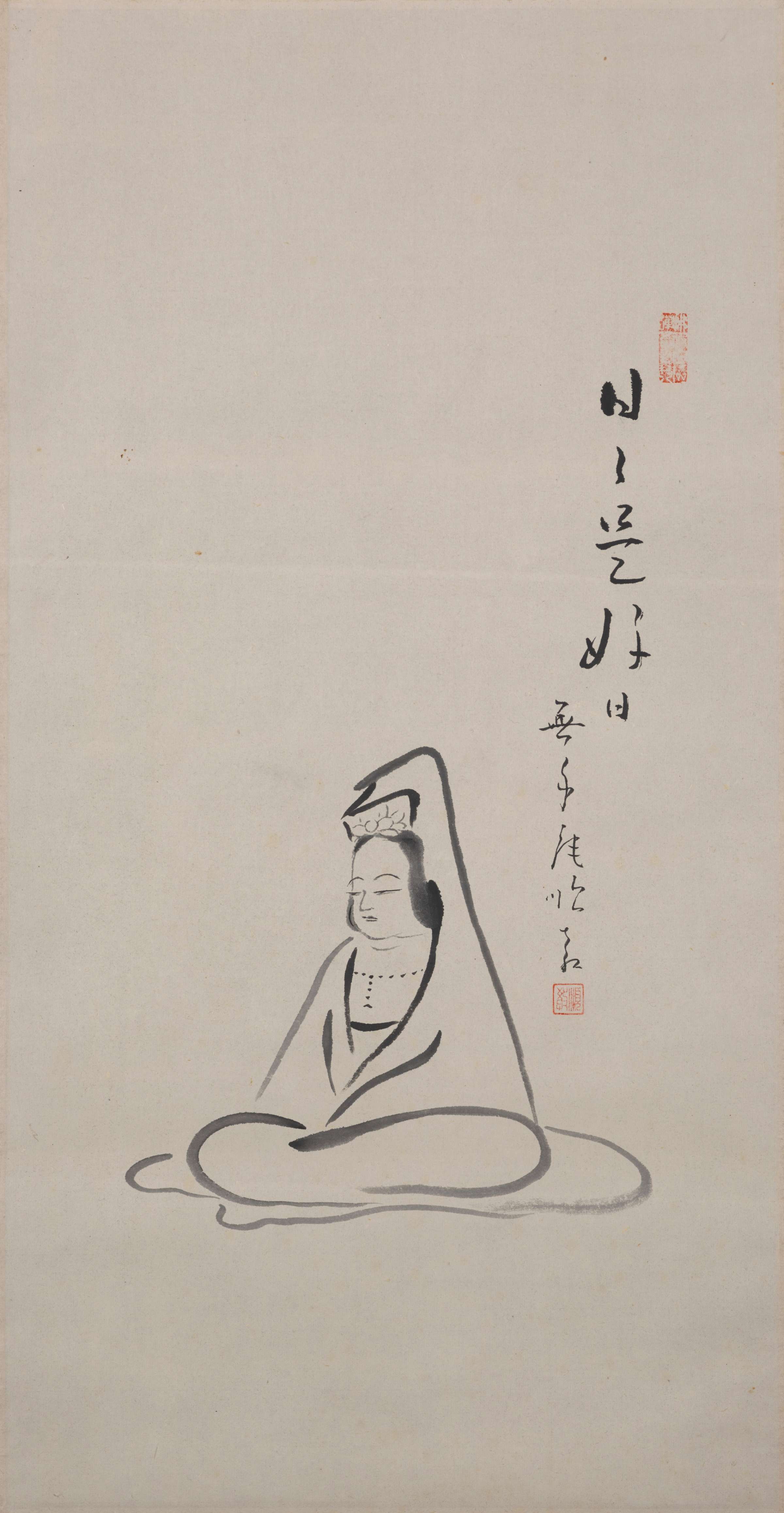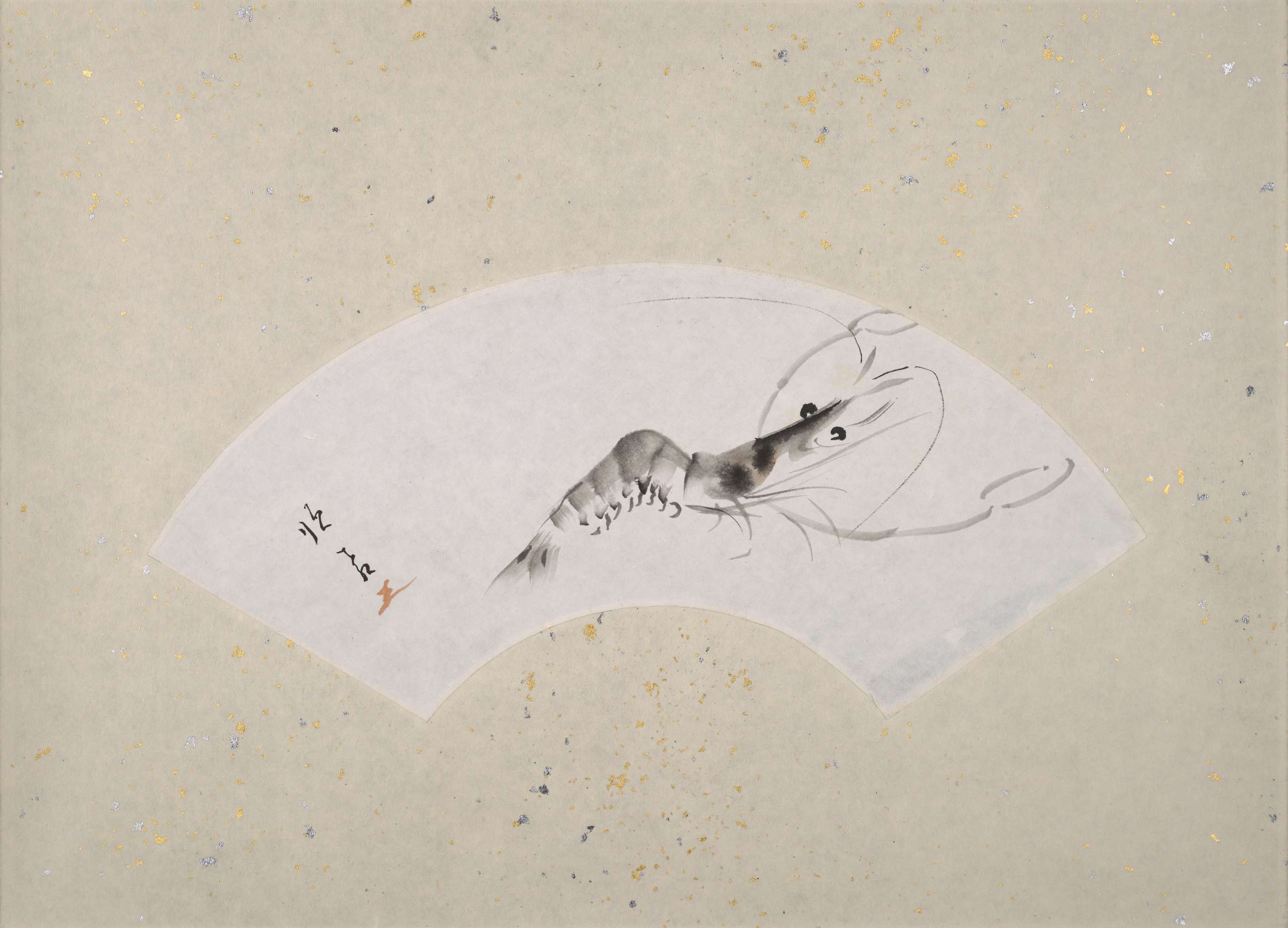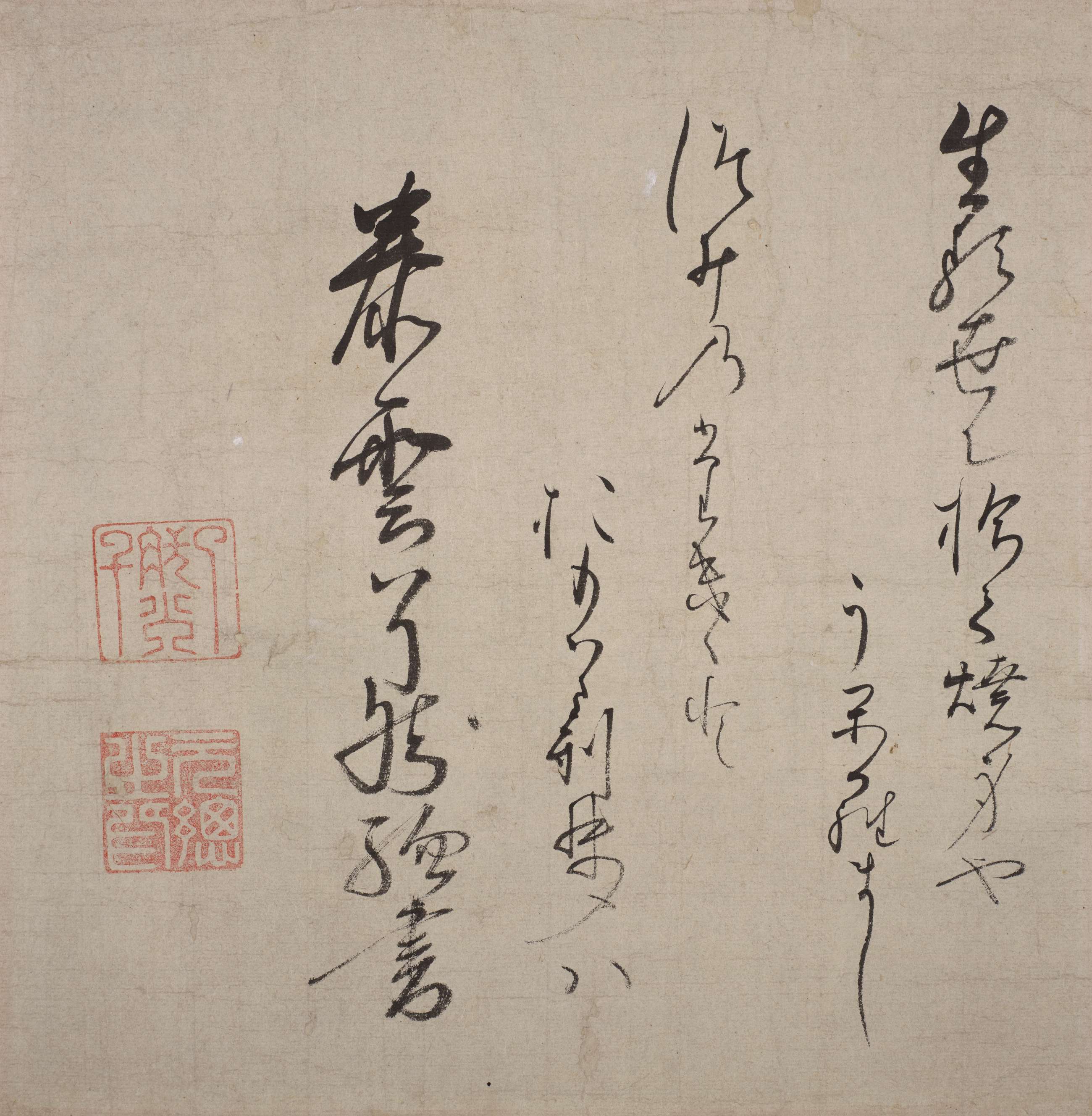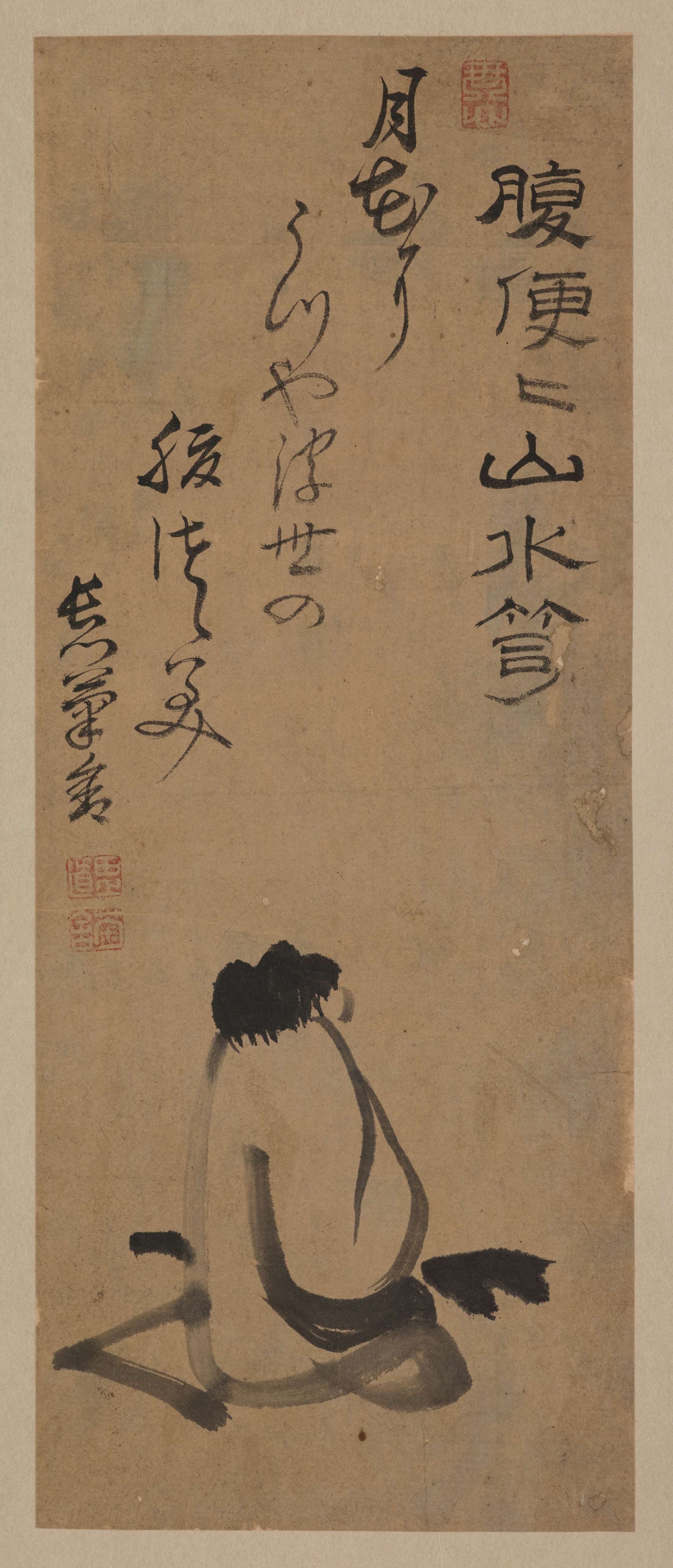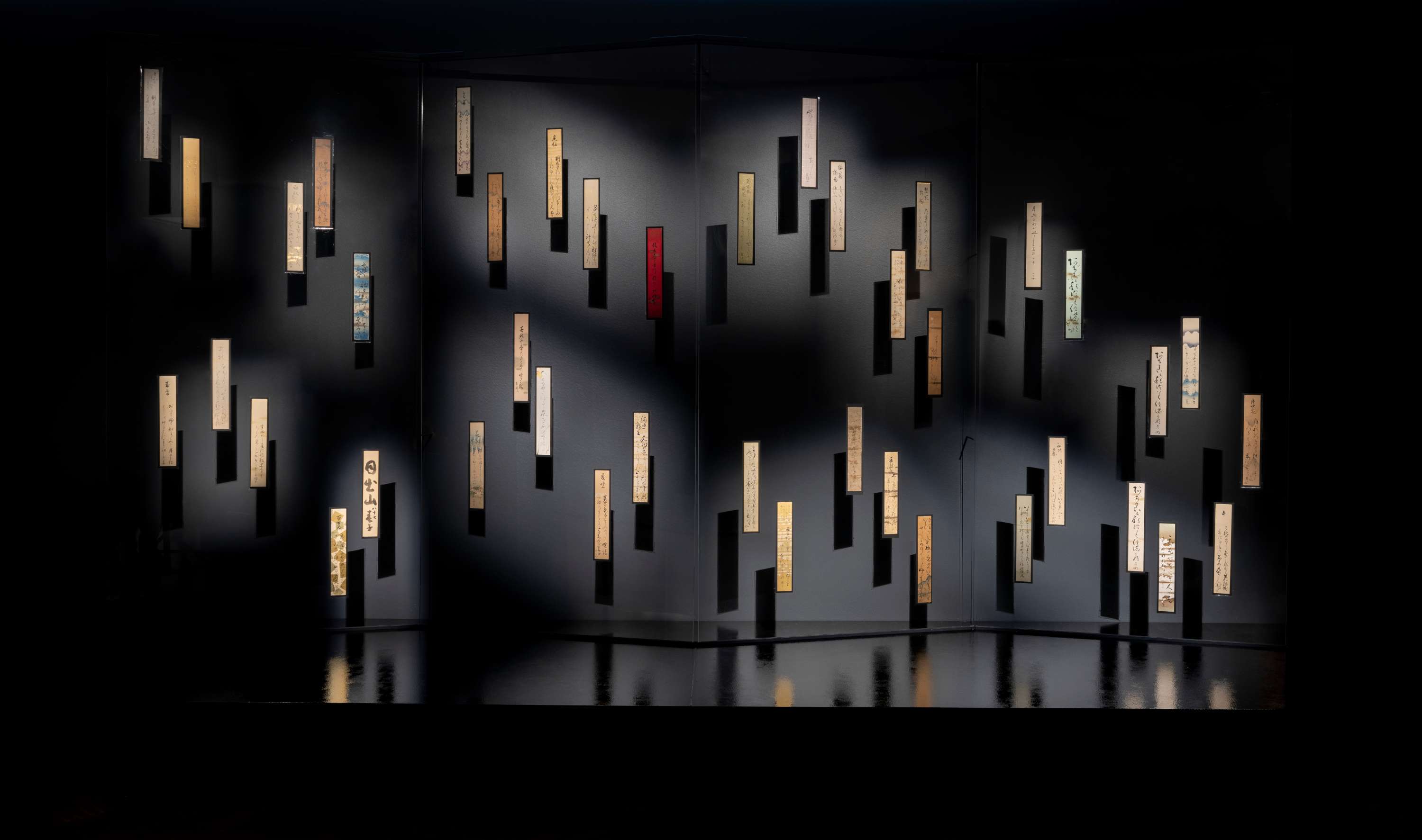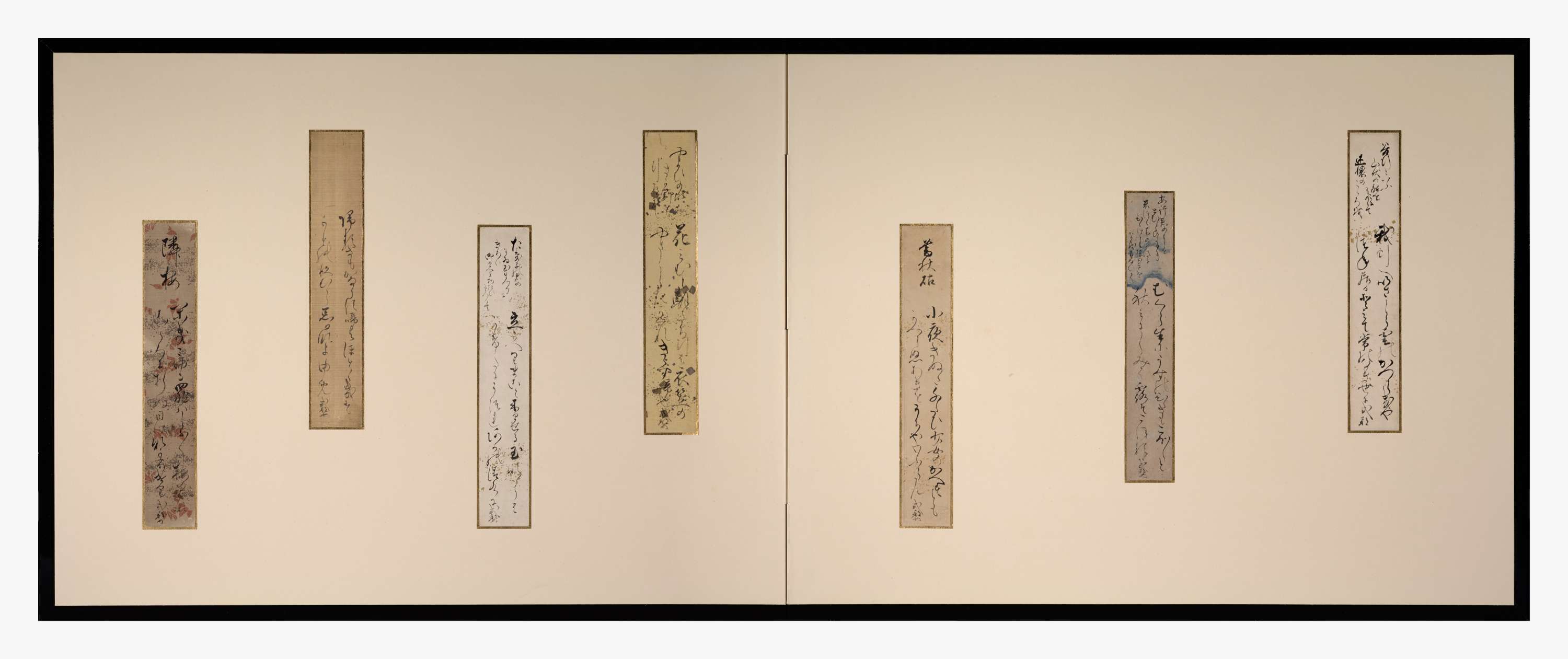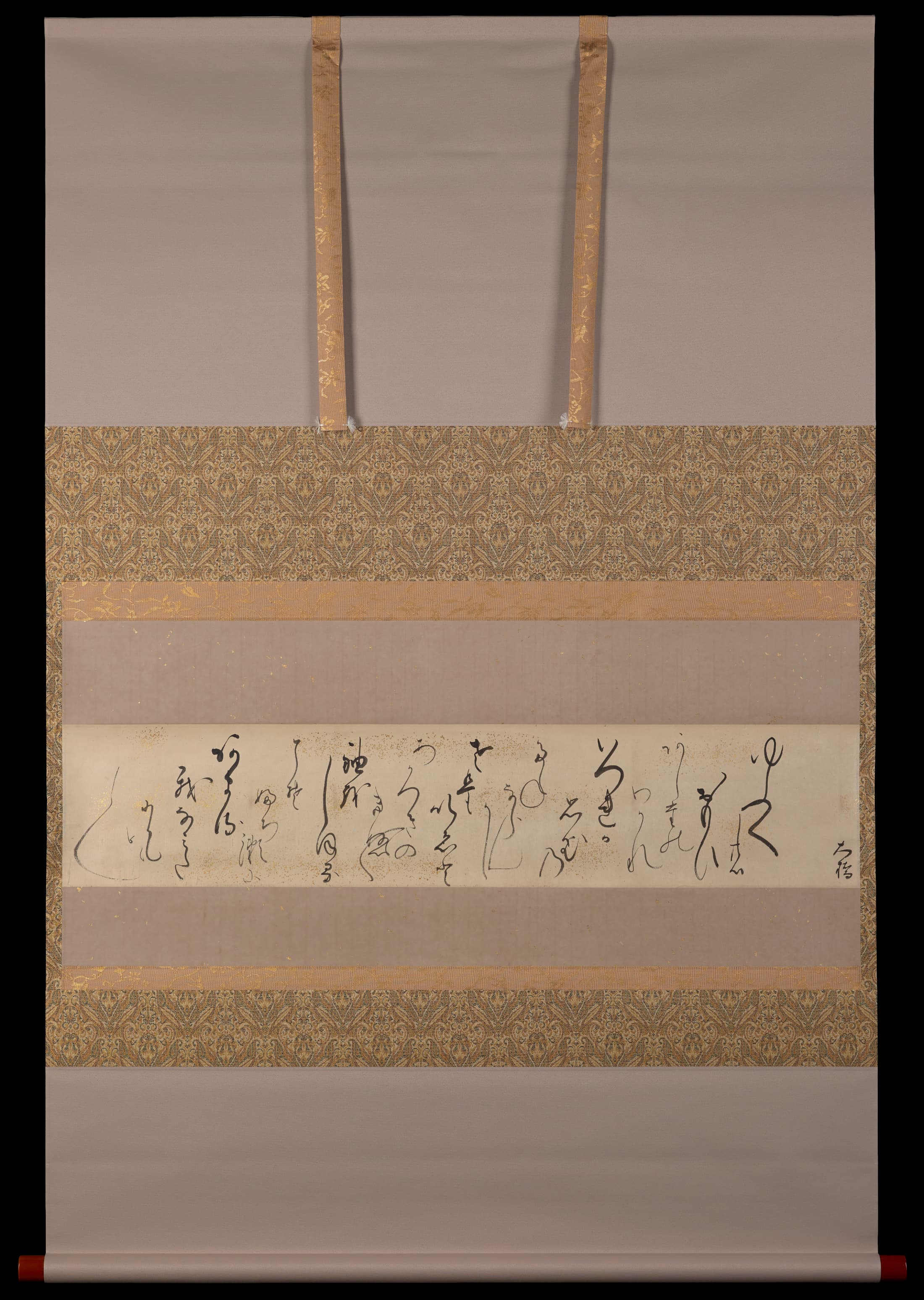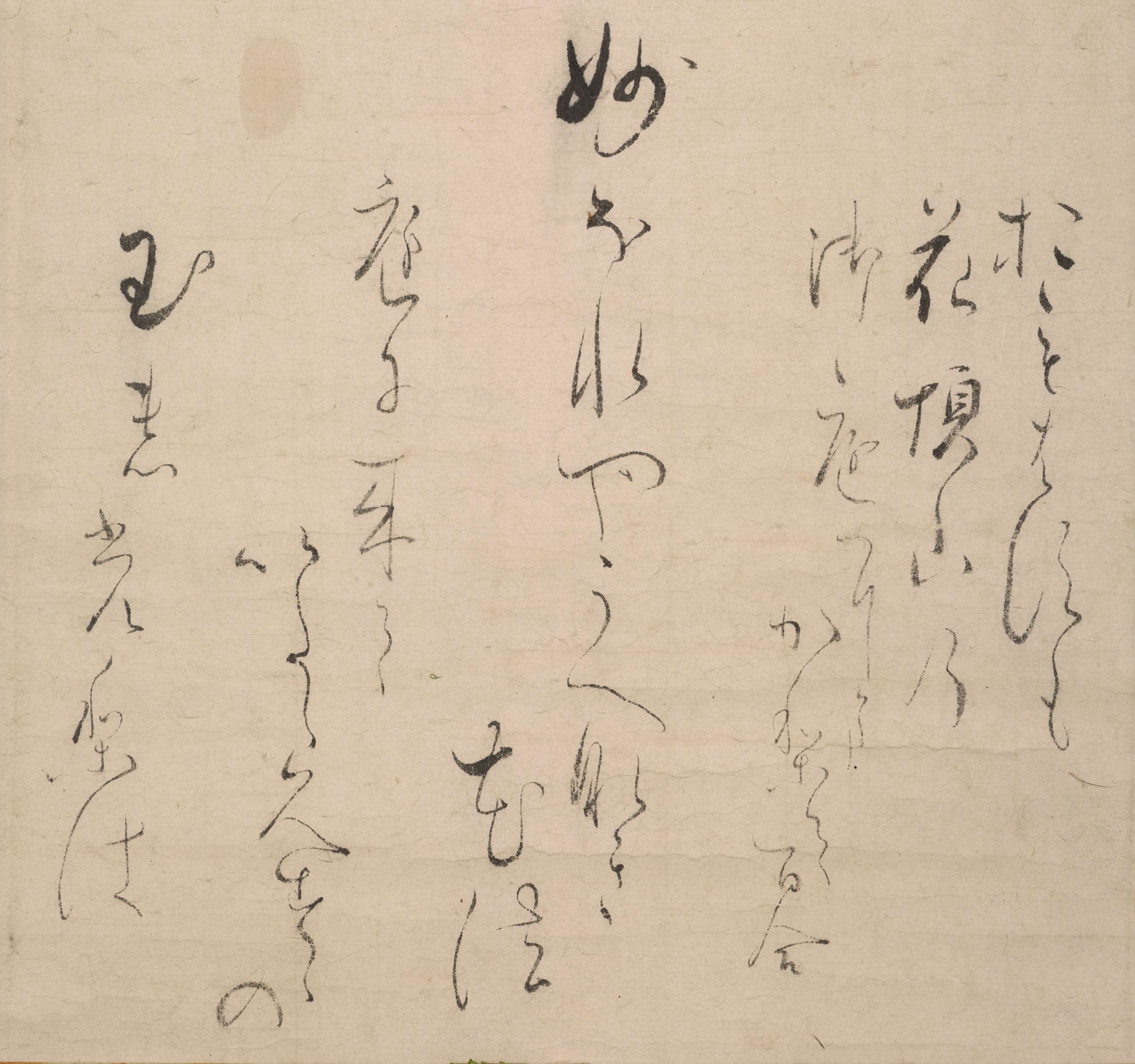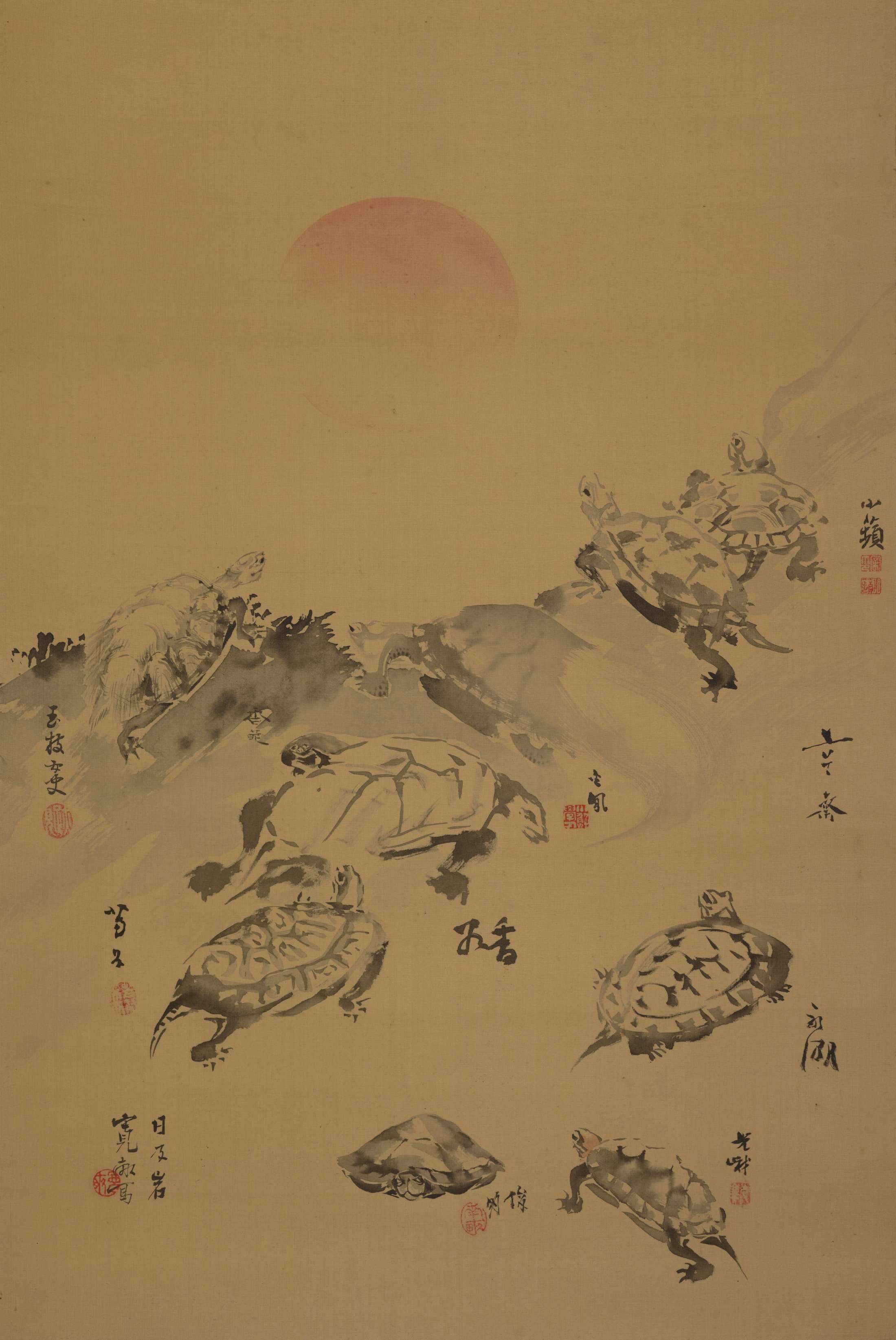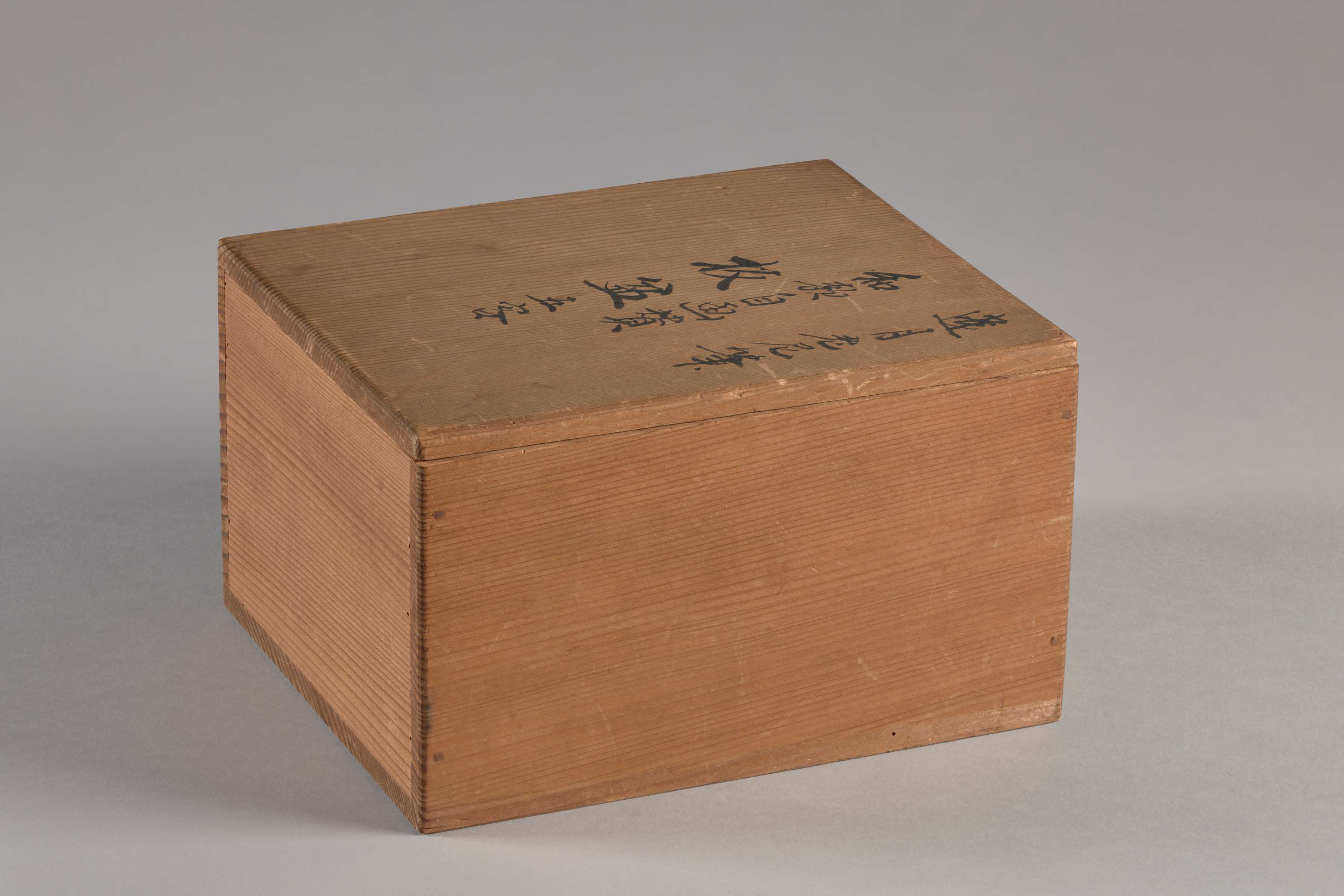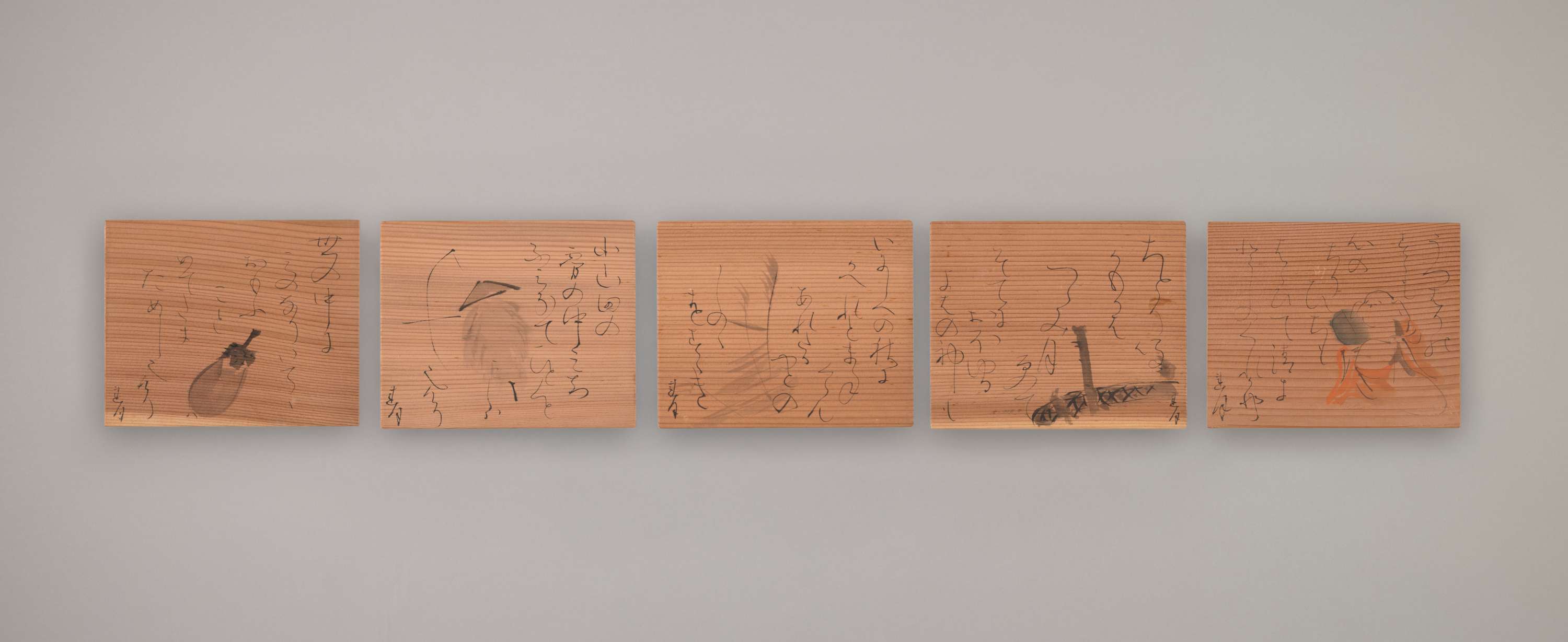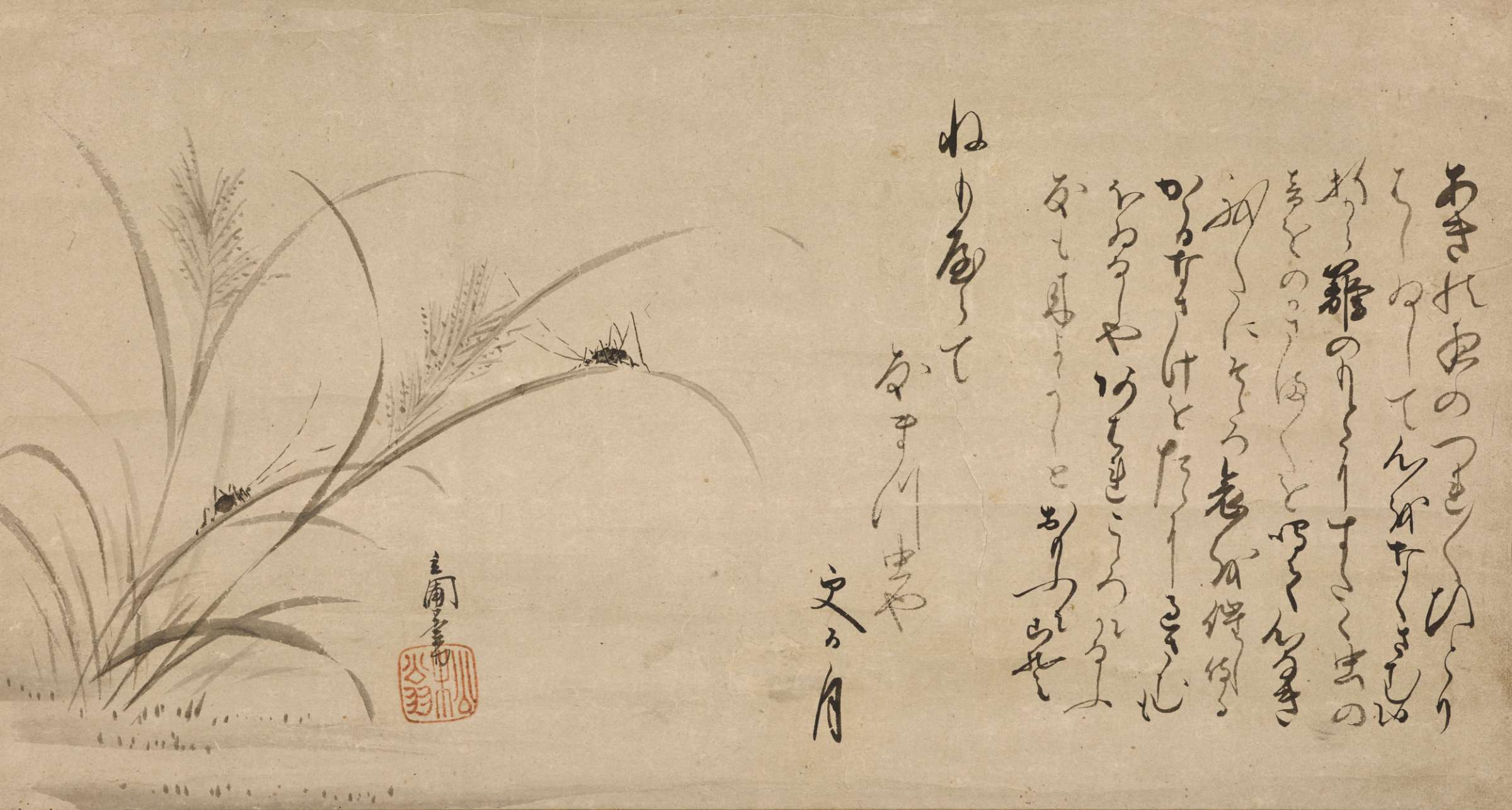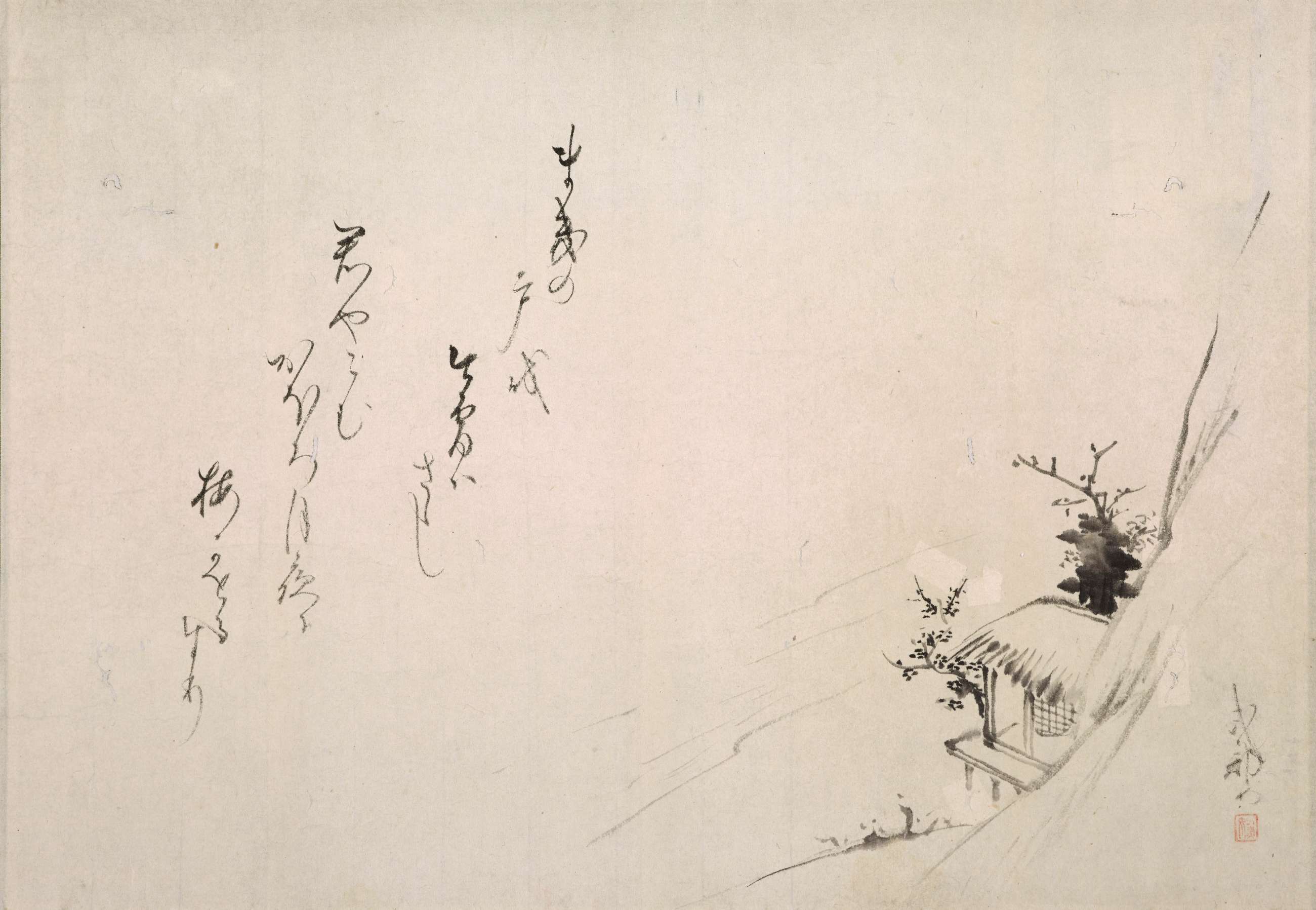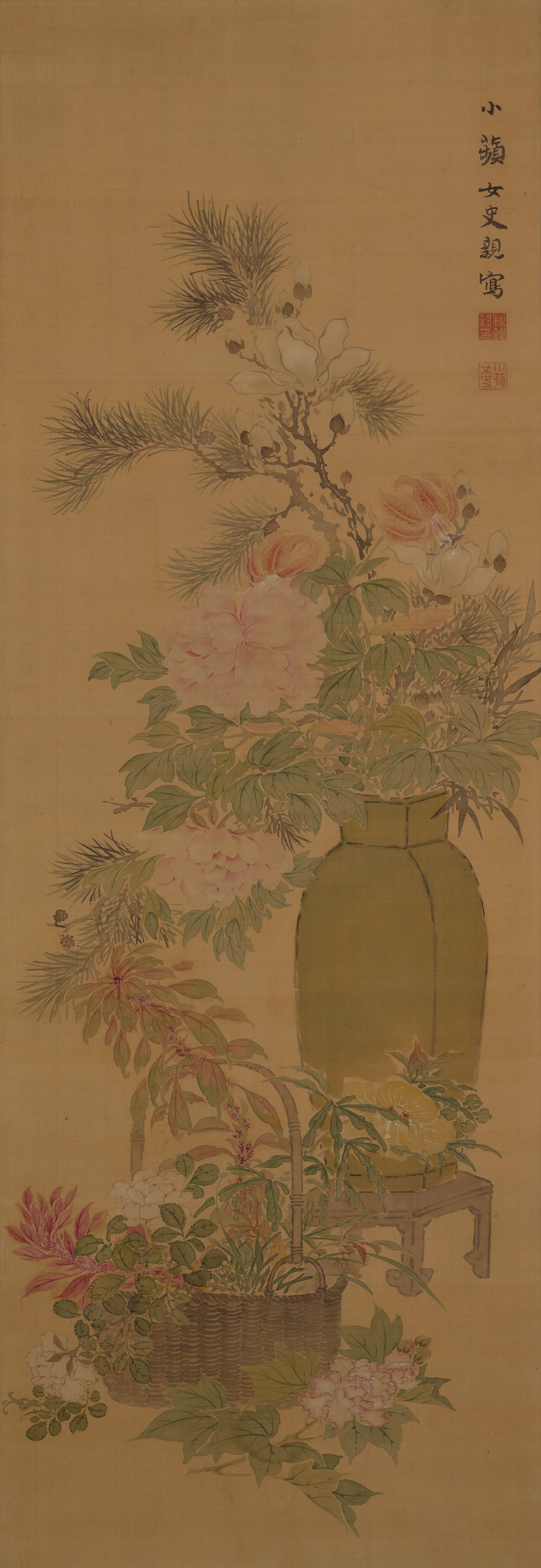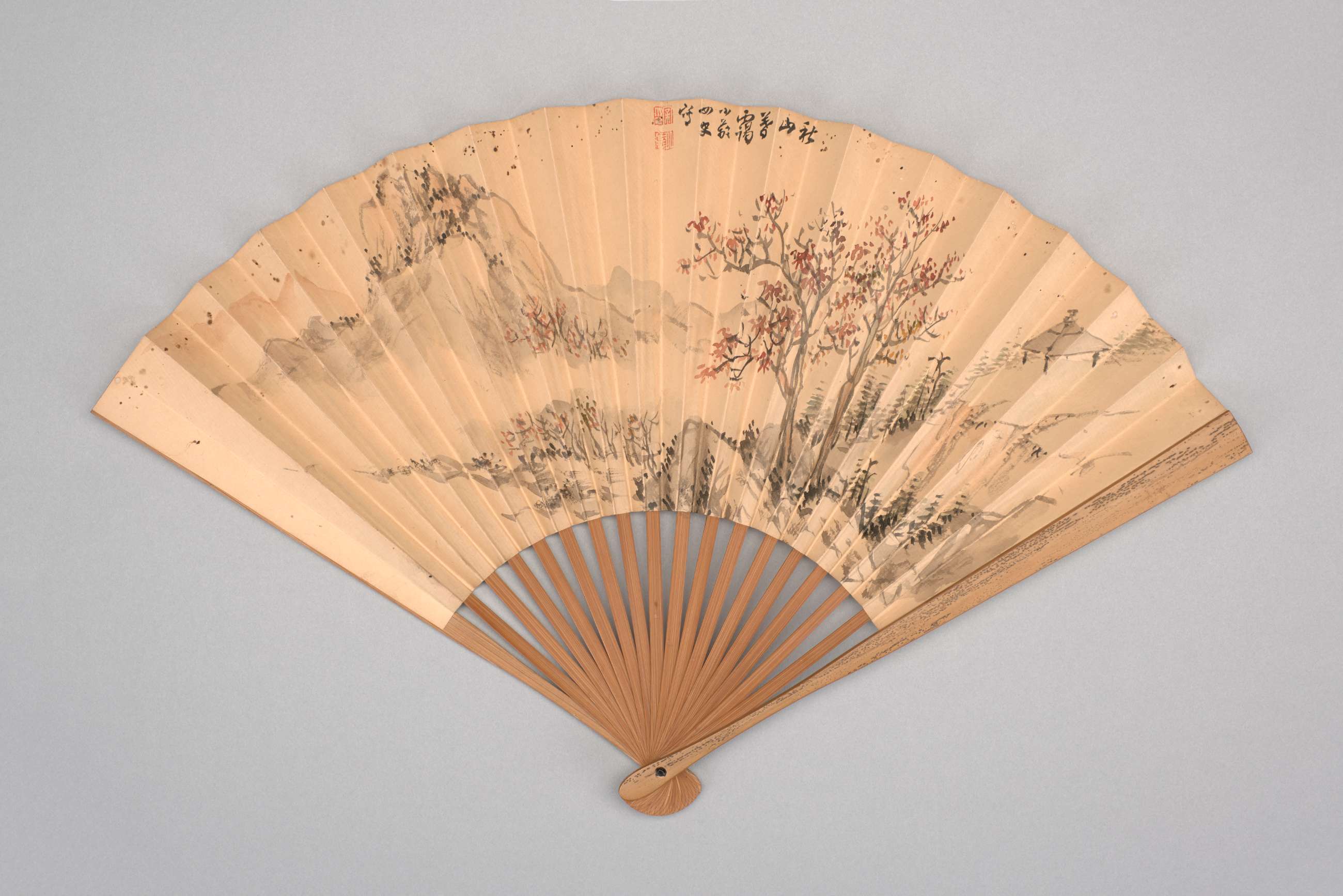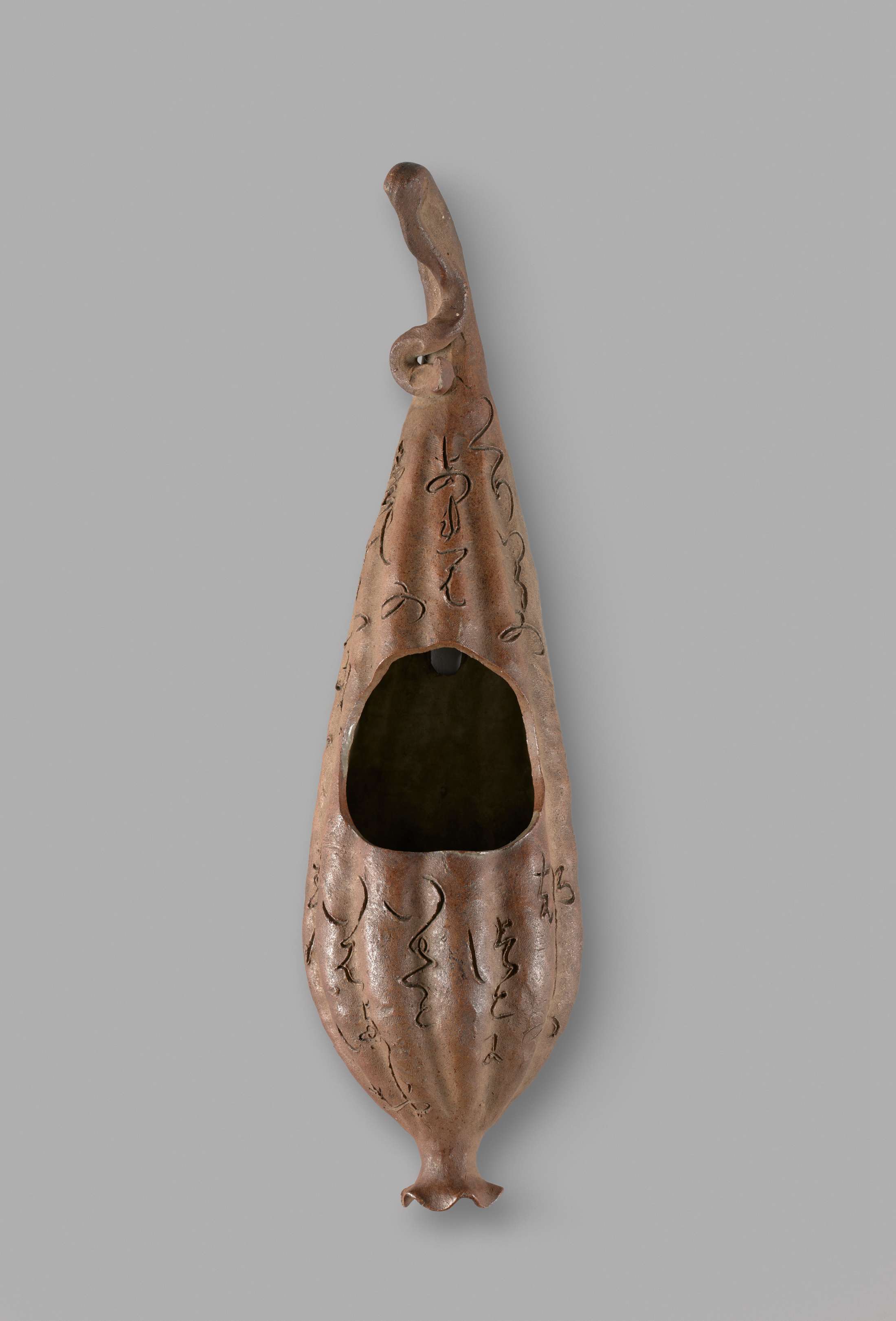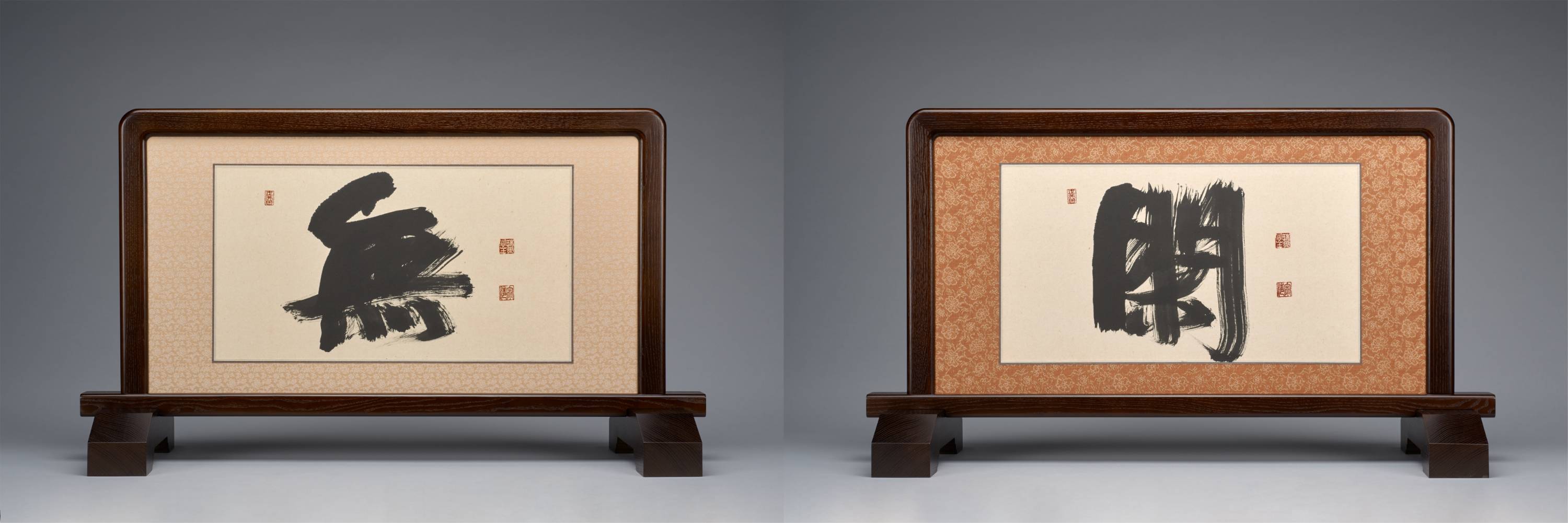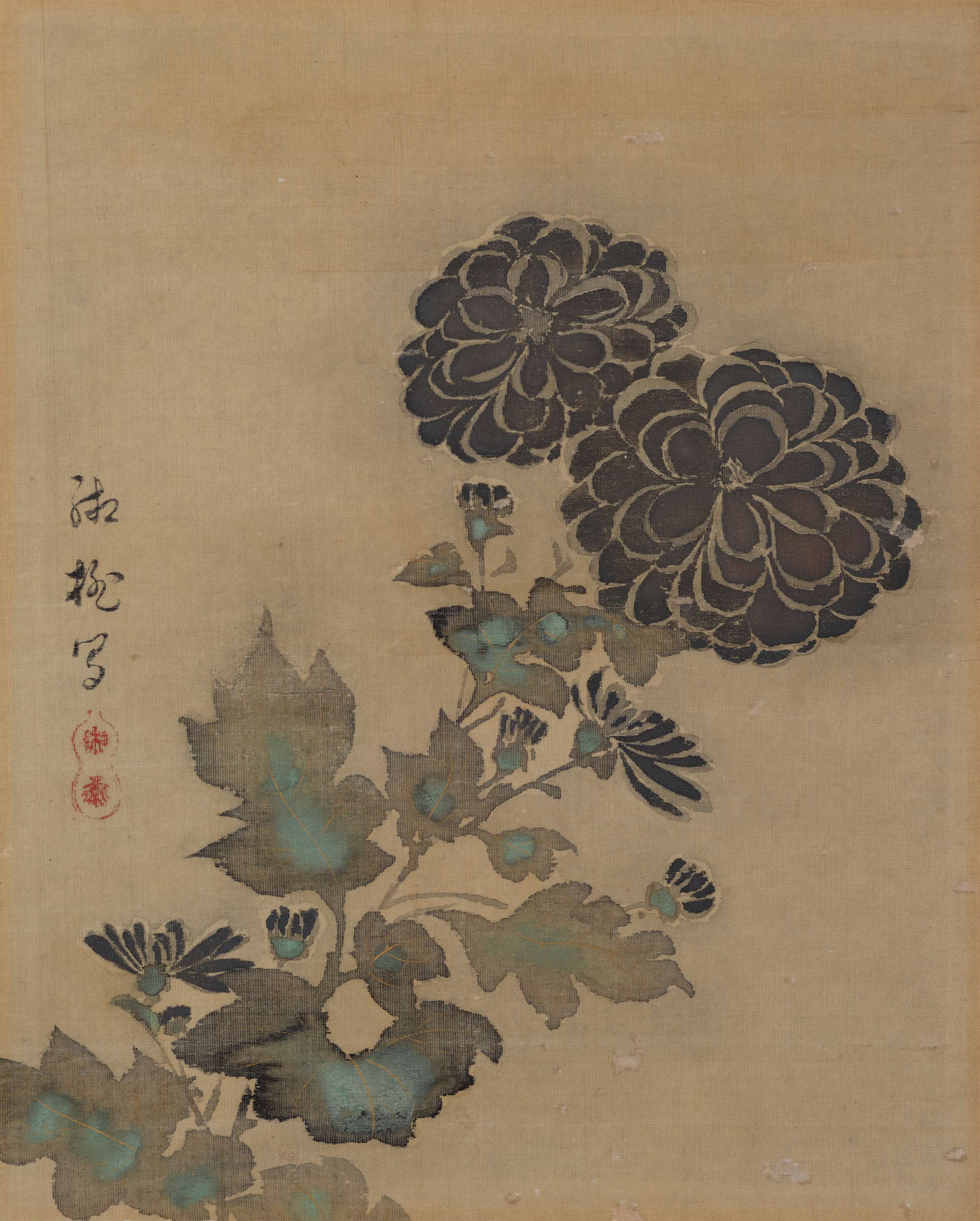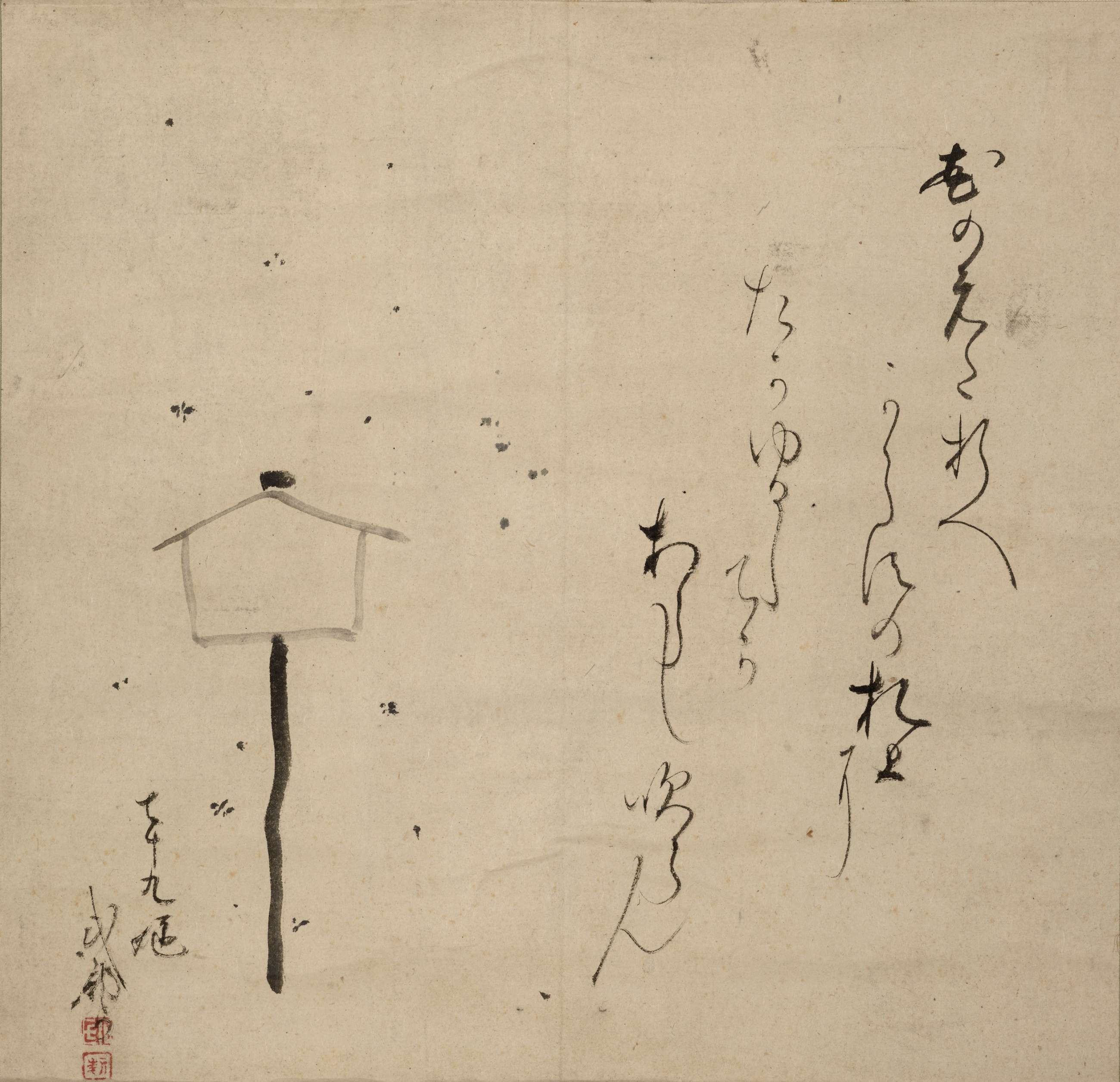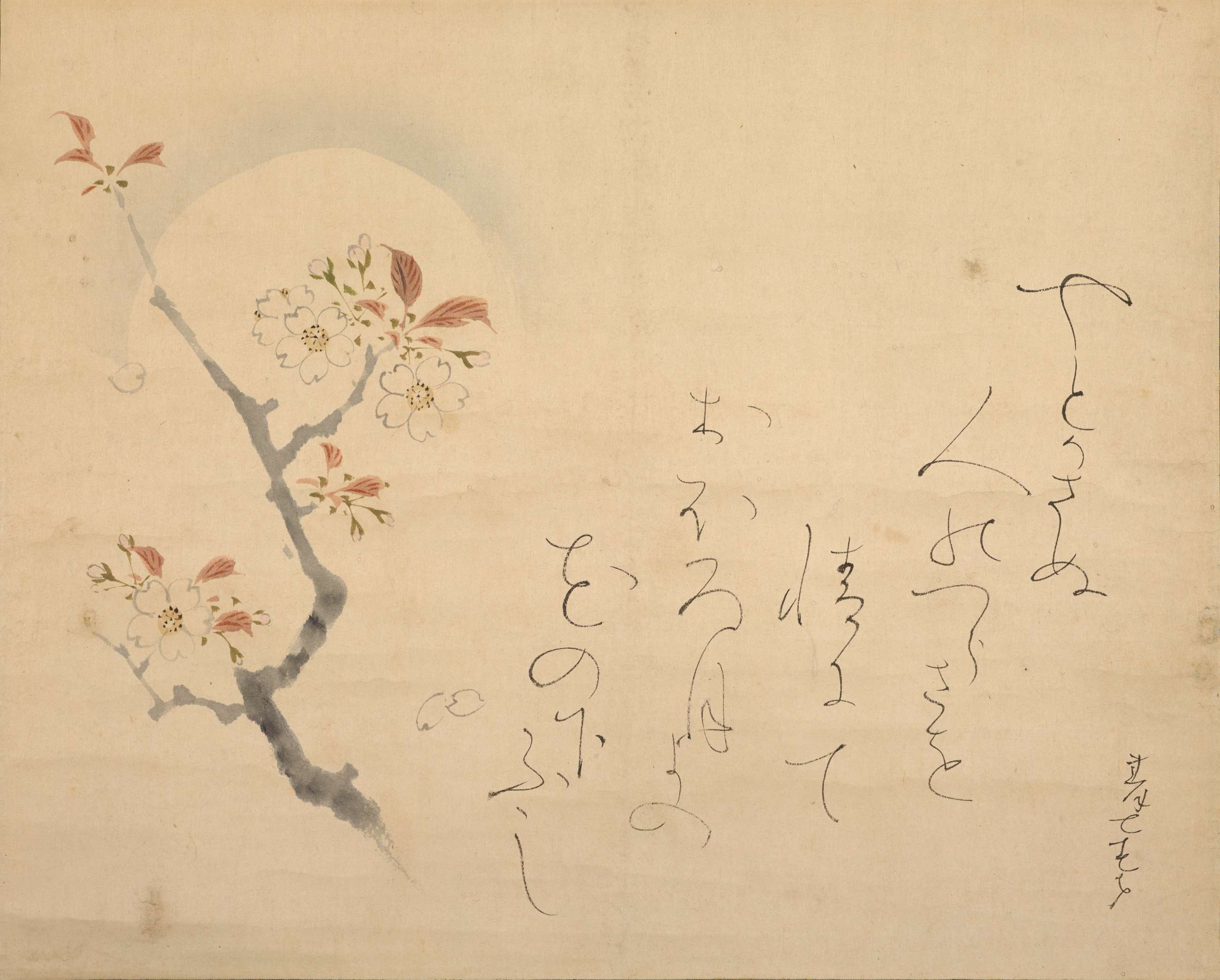Exhibition Checklist
All works in the exhibition are gifts of Drs. John Fong and Colin Johnstone.
Introduction
Ōtagaki Rengetsu 太田垣蓮月
1791–1875
1791–1875
Sake Decanter (tokkuri)
1800s
Glazed ceramic
5½ × 6 in. (14 × 15.2 cm)
2021.196
1
Kō (Ōshima) Raikin 高(大島)来禽
Active late 1700s
Active late 1700s
Autumn Landscape
Late 1700s
Ink and light color on paper
12⅞ × 8½ in. (32.7 × 21.6 cm)
2018.193
2
Takeuchi Shōran 武内小鸞
Active late 1700s–early 1800s
Active late 1700s–early 1800s
Bush Warbler on a Plum Branch
Early 1800s
Ink and color on silk
37½ × 14½ in. (95.3 × 36.8 cm)
2018.215
3
Katō Seiko 加藤青湖
Active 1800s
Active 1800s
Sparrows and Bamboo
About 1872
Ink and color on silk
49⅜ × 16⅛ in. (125.4 × 41 cm)
2018.212
4
Ōtagaki Rengetsu 太田垣蓮月
1791–1875
1791–1875
Waka Poem
About 1828/9 or 1840/41
Ink on decorated paper
13¼ × 2¼ in. (33.7 × 5.7 cm)
2018.181.3
5
Ōtagaki Rengetsu 太田垣蓮月
1791–1875
1791–1875
Two Poems on Uchiwa Fans
1800s
Ink on paper with bamboo ribbing, wood handles, silk tassels, and mica
Blue fan 14⅞ × 9½ × ¼ in. (37.8 × 24.1 × 0.6 cm), Beige fan 15 × 9⅜ × ¼ in. (38.1 × 23.8 × 0.6 cm)
2018.166.1-2
6
Ōtagaki Rengetsu 太田垣蓮月
1791–1875
1791–1875
Incense Container (kōgō) in the Shape of a Tanuki (raccoon dog)
1800s
Glazed ceramic
2¼ × 2½ in. dia. (5.7 × 6.4 cm. dia)
2021.199A-B
7
Ōtagaki Rengetsu 太田垣蓮月
1791–1875
1791–1875
Incense Box (kōgō) in the Shape of a Tortoise
1800s
Ceramic with gold and lacquer repair (kintsugi)
¾ × 1⅝ × 2¼ in. dia. (1.9 × 4.1 × 5.7 cm dia.)
2021.164A-B
8
Calligraphy by Ōtagaki Rengetsu 太田垣蓮月
1791–1875
Painting by Wada Gesshin 和田月心
1800–1870
1791–1875
Painting by Wada Gesshin 和田月心
1800–1870
Stag and Poem
About 1865–70
Ink on paper
26¾ × 7 ¾ in. (67.9 × 19.7 cm)
2018.245
9
Calligraphy by Ōtagaki Rengetsu 太田垣蓮月
1791–1875
Painting by Tomioka Tessai 富岡鉄斎
1836–1924
1791–1875
Painting by Tomioka Tessai 富岡鉄斎
1836–1924
Three Waka Poems and a Pine
1850–1900
Ink on paper
38¼ × 12 in. (97.2 × 30.5 cm)
2021.156
10
Kuroda Kōryō 黒田光良
1823–1895
1823–1895
Two Teabowls in the Style of Rengetsu (Rengetsu-yaki)
Late 1800s
Glazed ceramic
Each 1⅞ × 4½ in. dia. (4.6 × 11.4 cm dia.)
2018.259.1-2
11
Unidentified artist
Signed Mirei 美嶺
Signed Mirei 美嶺
The Three Obediences (sanjū)
1700–mid-1800s
Ink and color on paper
29⅛ × 9¾ in. (74 × 24.8 cm)
2018.146
12
Miwa Teishin 三輪貞信
1809–1902
1809–1902
Waka Poem on Poetry Slip (tanzaku)
Late 1800s
Ink on decorated paper
14¼ × 2⅜ in. (36.2 × 6 cm)
2018.182
13
Murase Myōdō 村瀬明道
1924–2013
1924–2013
Breaking Waves in the Pines (shōtō)
Late 1900s
Ink on paper
12⅝ × 23⅞ in. (32.1 × 60.6 cm)
2018.155
14
Kamei Shōkin 亀井少琴
1798–1857
1798–1857
Blossoming Plum
About 1850
Ink on paper
52¼ × 19 in. (132.7 × 48.3 cm)
2018.192
15
Inner Chambers
Artist unknown
Signed Kiyohara Yukinobu 清原雪信
Active 1600s–1700s
Signed Kiyohara Yukinobu 清原雪信
Active 1600s–1700s
Genji Peeping at the Young Murasaki
1600s
Ink and color on silk
15¼ × 21½ in. (38.7 × 54.6 cm)
2018.255
16
Ono no Ozū (or Ono no Otsū) 小野お通
1559/68–before 1650
1559/68–before 1650
The Deified Sugawara Michizane Crossing to China (Totō Tenjin)
Early 1600s
Ink on paper
25⅜ × 12¾ in. (64.5 × 32.4 cm)
2018.152
17
Yamazaki Ryūjo 山崎龍女
Active early 1700s
Active early 1700s
Hotei and His Bag of Treasure
Early 1700s
Ink on paper
17⅛ × 22 in. (43.5 × 55.9 cm)
2018.185
18
Tachihara Shunsa 立原春沙
1818–1858
1818–1858
Blossoming Plum
Mid-1800s
Ink and color on silk
41 × 14⅛ in. (104.1 × 35.9 cm)
2018.214
19
Nakayama Miya 中山三屋
1840–1871
1840–1871
Chrysanthemums
Mid-1800s
Ink and color on paper
54¼ × 12 in. (137.8 × 30.5 cm)
2018.218
20
Nakayama Miya 中山三屋
1840–1871
1840–1871
Blossoming Plums
Mid-1800s
Ink on paper
35½ × 10½ in. (90.2 ×26.7 cm)
2018.221
21
Attributed to Oda Shitsushitsu 織田瑟瑟
1779–1832
1779–1832
Blossoming Cherry Tree
Early 1800s
Ink and color on paper
45⅞ × 20⅞ in. (116.5 × 53 cm)
2018.213
22
Daughters of the Atelier
Kiyohara Yukinobu 清原雪信
1643–1682
1643–1682
The Goddess Benzaiten and Her Lute (biwa)
1660–82
Ink, color, and gold on silk
32⅝ × 14⅛ in. (82.9 × 35.9 cm)
2018.150
23
Nakabayashi Seishuku 中林清淑
1829–1912
1829–1912
Blossoming Plum and Bamboo
1893
Ink on paper
54¼ × 13¼ in. (137.8 × 33.7 cm)
2018.194
24
Hirata Gyokuon 平田玉蘊
1787–1855
1787–1855
Queen Mother of the West and Attendant
About 1839
Ink and color on silk
44⅞ × 16½ in. (114 × 41.9 cm)
2018.211
25
Taking the Tonsure
Suganuma Ōhō 菅沼大鳳
Active early 1900s
Active early 1900s
Rengetsu Working in Her Hut
1935
Ink and color on paper
45⅛ × 16⅞ in. (114.6 × 42.9 cm)
2018.165
26
Ōtagaki Rengetsu 太田垣蓮月
1791–1875
1791–1875
Travel Journal to Arashiyama (Arashiyama hana no ki)
1800s
Ink and color on paper
1¼ × 4¼ × 6½ in. (3.2 × 10.8 × 16.5 cm)
2021.206
27
Ōishi Junkyō 大石順教
1888–1968
1888–1968
Bodhisattva Kannon (Avalokiteśvara)
Mid-1900s
Ink on paper
25⅝ × 13⅜ in. (65.1 × 34 cm)
2018.156
28
Daitsū Bunchi 大通文智
1619–1697
1619–1697
Bodhisattva of Myriad Acts of Compassion (Jihi Mangyō Bosatsu)
1600s
Ink on paper
38¾ × 11 in. (98.4 × 27.9 cm)
2018.153
30
Ryōnen Gensō 了然元総
1646–1711
1646–1711
Poem
1701–11
Ink on paper
11¼ × 11 in. (28.6 × 27.9 cm)
2018.159
31
Image by Utagawa Kunisada 歌川国貞
1786–1864; Inscription by Ryūtei Tanehiko 柳亭種
1783–1842
1786–1864; Inscription by Ryūtei Tanehiko 柳亭種
1783–1842
“The Nun Ryōnen (Ryōnen-ni)” from Kokon meifuden [Famous women of past and present] Ryōnen Gensō 了然元総, 1646–1711
1854 edition
Color woodblock print
14⅞ × 9¾ in. (37.8 × 24.8 cm)
2018.160
32
Tagami Kikusha 田上菊舎
1753–1826
1753–1826
Hermit/Self-Portrait
Early 1800s
Ink on paper
11½ × 4⅝ in. (29.2 × 11.7 cm)
2018.222
33
Floating World
Various artists
Poem Slips (tanzaku)
1700–1900s
Pigment, gold, silver, and ink on paper
Each approx. 13 × 2 in. (33 × 5 cm)
2018.181.3-44
34
Artist Unknown
Poetry Slip Box (tanzaku) with God of Longevity (Juro–jin) and Deer
1800s
Lacquer, wood, gold, silver, and cinnabar
15⅝ × 3½ × 1½ in. (39.7 × 8.9 × 3.8 cm)
2018.184.1A-B
35
Attributed to Takabatake Shikibu 高畠式部
1785–1881
1785–1881
Seven Waka Poems
1800s
Ink on decorated paper
Overall 28 × 71 × ¾ in. (71.1 × 180.3 ×1.9 cm)
2018.226
36
Sakuragi-dayū (The Tayū Sakuragi) 桜木太夫
Active mid- to late 1800s
Active mid- to late 1800s
Poetry Slip (tanzaku) with Poem on Pampas Grass (obana)
Mid-1800s
Pigment, gold, and ink on paper
13½ × 2¼ in. (34.3 × 5.6 cm)
2018.181.2
37
Ōhashi-dayū (The Tayū Ōhashi) 大橋太夫
Active 1700s
Active 1700s
Two Poems
Mid-1700s
Ink on paper
7½ × 36⅝ in. (145.4 × 96.5 cm)
2018.183
38
Yuri of Gion 祇園の百合
1694–1764
1694–1764
Waka Poem
Mid-1700s
Ink on paper
11⅛ × 11⅞ in. (28.3 × 30.2 cm)
2018.186
39
Kaji of Gion 祇園梶子
Active late 1600s
Active late 1600s
Waka Poem
Late 1600s–early 1700s
Ink on paper
13⅜ × 2⅜ in. (34 × 6 cm)
2018.181.1
40
Ōtagaki Rengetsu 太田垣蓮月
1791–1875
1791–1875
Sake Flask
1800s
Glazed ceramic
5¼ × 3 in. dia. (13.3 × 7.6 cm dia.)
2018.175
41
Ōtagaki Rengetsu 太田垣蓮月
1791–1875
1791–1875
Sweets Dish in the Form of a Lotus with Poem
1800s
Glazed ceramic
1¾ × 6 in. dia. (4.4 × 15.2 cm dia.)
2021.205
42
Literati Circles
Tokuyama (Ike) Gyokuran 徳山(池)玉瀾
1727–1784
1727–1784
Blossoming Plum
Mid-1700s
Ink on paper
52¾ × 18⅜ in. (134 × 46.7 cm)
2018.208
43
Various artists
Turtles on New Year’s Morn
About 1894
Ink and color on silk
18⅞ ×12¾ in. (47.9 × 32.4 cm)
2018.202
44
Ōtagaki Rengetsu 太田垣蓮月
1791–1875
1791–1875
Teapot for Sencha
1800s
Ceramic
1¾ × 4¼ in. dia. (4.4 × 10.8 cm dia.)
2021.163A-B
45
Ōtagaki Rengetsu 太田垣蓮月
1791–1875
1791–1875
Set of Five Sencha Cups
1800s
Glazed ceramic
Each approx. 1⅜ × 2 in. dia. (3.5 × 5.1 cm dia.)
2021.170.1-5
46
Unknown maker
Lidded Wooden Box (tomobako) with Inscription by Priest Kōen of the Jinkō-in temple
1800s
Wood
4¼ × 7¼ × 6¼ in. (10.8 × 18.4 × 15.9 cm)
RA.2021.198
47
Ōtagaki Rengetsu 太田垣蓮月
1791–1875
1791–1875
Sweets Plates with Paintings and Poems
1800s
Ink and color on cedar planks
Each 5¼ × 6½ × ¼ in. (13.3 × 16.5 × 0.6 cm)
2021.198.1-5
48
Tomioka Haruko 富岡春子
1847–1940
1847–1940
Bodhisattva Kannon (Avalokiteśvara)
1926
Ink on paper
14 × 12¾ in. (35.6 × 32.4 cm)
2018.251
49
Kaga no Chiyo 加賀千代
1703–1775
1703–1775
Haiku (hokku) Poem
About 1755–75
Ink on paper
13⅞ × 17½ in. (35.2 × 44.5 cm)
2018.217
50
Attributed to Nonoguchi Ryūho 野々口立圃
1595–1669
1595–1669
Haibun and Haiga of Crickets
Mid-1600s
Ink on paper
9⅞ × 18¼ in. (25.1 × 46.4 cm)
2020.570
51
Takabatake Shikibu 高畠式部
1785–1881
1785–1881
Mountain Studio in Early Spring
1800s
Ink on paper
12¼ × 17⅞ in. (31.1 × 45.4 cm)
2018.225
52
Takabatake Shikibu 高畠式部
1785–1881
1785–1881
Bamboo and Poem
1861
Ink on paper
12⅝ × 17½ in. (32.1 × 44.5 cm)
2018.224
53
Ema Saikō 江馬細香
1787–1861
1787–1861
The Three Friends of Winter
1857
Ink and light color on paper
46⅝ × 11 in. (118.4 × 27.9 cm)
2018.189
54
Hashimoto Seikō 橋本青江
1821–1898
1821–1898
Orchids
Mid-1800s
Ink on paper
56¼ × 14⅞ in. (142.9 × 37.8 cm)
2018.190
56
Okuhara Seiko 奥原晴湖
1837–1913
1837–1913
Orchids on a Cliff
1870–80s
Ink on paper
53⅞ × 13¼ in. (136.8 × 33.7 cm)
2018.206
57
Okuhara Seiko 奥原晴湖
1837–1913
1837–1913
Flowering Plants of the Four Seasons
1898
Ink and color on paper mounted on cabinet doors
Each 8⅞ × 12⅞ in. (22.5 × 32.7 cm)
2018.247A-B
58
Noguchi Shōhin 野口小蘋
1847–1917
1847–1917
Cut Flowers and Pine Bough
Late 1800s–early 1900s
Ink and color on silk
49 × 17 in. (124.5 × 43.2 cm)
2018.196
59
Noguchi Shōhin 野口小蘋
1847–1917
1847–1917
Fan with Scene of Autumn Mountains and Mist
Late 1800s–early 1900s
Ink and light color on paper with bamboo support
9¼ × 15¼ × ½ in. (23.5 × 38.7 × 1.3 cm)
2018.195
60
Noguchi Shōhin 野口小蘋
1847–1917
1847–1917
Fan with Summer Scene
Late 1800s
Ink and color on silk with bamboo and lacquered wood support
9 × 14¼ × ½ in. (22.9 × 36.2 × 1.3 cm)
2018.201
61
Ōtagaki Rengetsu 太田垣蓮月
1791–1875
1791–1875
Hanging Flower Vase (hana-ike) in the Shape of a Hechima Gourd
1800s
Ceramic
11 × 4½ in. dia. (27.9 × 11.4 cm dia.)
2021.184
62
Yanagawa (Chō) Kōran 柳川(張)紅蘭
1804–1879
1804–1879
Summer Landscape
1876
Ink on paper
41¾ × 14¾ in. (106 × 37.5 cm)
2018.207
63
Unstoppable (No Barriers)
Murase Myōdō 村瀬明道
1924–2013
1924–2013
Mu (Emptiness) and Kan (Quietude)
Late 1900s
Ink on paper with wood frame
*Mu* 13 × 23⅞ in. (33 × 60.6 cm), *Kan* 15¼ × 23⅞ in. (38.7 × 60.6 cm)
2018.154A-C
64
Ōishi Junkyō 大石順教
1888–1968
1888–1968
Willow and Frog
Mid-1900s
Ink on paper
15 × 19¾ in. (38.1 × 50.2 cm)
2018.157
65
Yamamoto Shōtō 山本緗桃
1757–1831
1757–1831
Chrysanthemums
Late 1700s–early 1800s
Ink, color, and gold on silk
9⅛ × 7⅜ in. (23.2 × 18.7 cm)
2018.216
66
Takabatake Shikibu 高畠式部
1785–1881
1785–1881
Signboard
1863
Ink on paper
11 × 11½ in. (27.9 × 29.2 cm)
2018.253
67
